TIGRAY-TIGRINYA (TIGRAY/BIHER-TIGRINYA/KEBESSA) PEOPLE: CULTURALLY DOMINANT AND POLITICALLY POWERFUL PEOPLE OF ETHIOPIA AND ERITREA
The Tigray-Tigrinya (ትግራይ - ትግርኛ) or Biher-Tigrinya or the Kebessa people or simply Tigrays are culturally dominant and politically powerful agriculturalist and Semitic-speaking ethnic group of the larger Afro-Asiatic language inhabiting the southern and central parts of Eritrea and the northern highlands of Ethiopia's Tigray Region. The Eritrean Tigrinya constitutes the largest ethnic group in the Eritrea nation.

Tigrinya people at their traditional wedding at Asmara, Eritrea
The Tigray-Tigrinya shares common ancestral imperial heritage with the Amhara people of Ethiopia and the two together built the powerful ancient Kingdom of Aksum in Ethiopia. Though, the seat of the ancient Aksumite Kingdom resided in Tigray territory, but the Tigray have not been as thoroughly studied as their culturally similar neighbors, the Amhara.

Tigray people of Ethiopia
In Ethiopia, prior to 1995, Tigray-Tigrinya lived in the former provinces of Tigray, Begemder (Gonder), and Wollo, with the regions within these provinces that they inhabited (e.g. Wolqayt, Tsegede, Tselemti, Raya, Humera) later incorporated into the modern Tigray Region. The Tigray people, eponymous with the name of their territory, make up approximately 96.6% of the inhabitants of the Tigray Region, and comprise 6.1% of Ethiopia's total population, numbering a little over 5.7 million.

In in Eritrea where they are the largest ethnic group, the Tigrays are simply known by the name of their language, as the Tigrinya. Officially and collectively they are also referred to as the Biher-Tigrinya, roughly meaning "Tigrinya nation". Since they primarily lived in a region of Eritrea known as the Kebessa, which was within the former awrajas of Hamasien, Seraye, and Akele Guzay, and are now incorporated into Eritrea's present-day regions, they are also called Kebessa people. Most of them live in rural areas in the highland administrative regions of Maekel (Central), Debub (Southern), the eastern fringes of Anseba and Gash Barka regions as well as the western fringes of Semenawi Keyih Bahri (Northern Red Sea). They are small holding farmers largely inhabiting small communal villages. The Tigrinya constitute around 50% of the Eritrean population, at about 3.4 million people.

Tigray-Tigrinya ladies
It must be emphasized, however, that a significant number of Muslim Tigrinya speakers refuse to identify themselves as Tigrinya and consequently constitute a separate ethnic group known as the Jeberti. These Jeberti people trace their origins in early Muslim migrants from the Arabian Peninsula to Tigray; they make up about 5% of the Eritrean population.
Asmara, as well as Mendefera, Dekemhare, Segeneiti, Adi Keyh, Adi Quala and Senafe. There is also a significant population of Biher-Tigrinya in other cities, including Keren and Massawa.

Geography and Climate
The terrain is high plateau, cut through by deep ravines. Nearly all the land is either under cultivation or in pasturage, although reserved areas that surround churches suggest that the climax growth of much of Tigray is cedar forest.

The average annual rainfall hovers around the 50 centimeters required for cereal agriculture. Droughts are frequent. Rainfall concentrates in two periods: the "large rains" fall for three months beginning in mid-June and the "small rains"—if they come—fall in January or February. Most Tigray live in the highlands, where daytime high temperatures are relatively cool (21° to 27° C); nighttime temperatures occasionally plunge below freezing in December.

Beautiful Ashenda girls in Tigrai state Northern Ethiopia Ashenda is a unique beautiful Tigraian traditional festival where young ladies and girls enjoy Ashenda music
Language
The mother tongue of the Tigray-Tigrinya is the Tigrinya language or Tigrigna or simply as Tigray. Tigrinya language belongs to the Ethiopian Semitic sub-group of the the larger Afro-Asiatic language family. Tigrinya is descended from an ancient Semitic language called Ge'ez, which the modern Ethiopian and Eritrean Orthodox Churches officially use as a liturgical language. The Tigrinya language is the direct descendant of Ge'ez, unlike Amharic (thought to be descended from a specific dialect or cluster of dialects of Ge'ez) and other southern Ethiopian Semitic languages, though Tigre may share this distinction with Tigrinya (its status is uncertain).
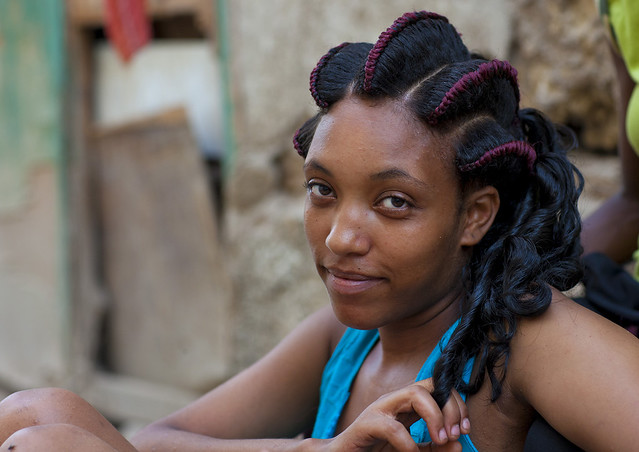
Eritrean Tigrinya woman with her traditional hairstyle, Asmara, Eritrea
Tigrinya is closely related to the Tigre language, another Afro-Asiatic language spoken by the Tigre people as well as many Beja. Tigrinya and Tigre although close are not mutually intelligible, and while Tigrinya has traditionally been written using the same Ge'ez script (fidel) as Amharic, Tigre has been transcribed mainly using the Arabic script. Attempts by the Eritrean government to have Tigre written using the Ge'ez script has met with some resistance from the predominantly Muslim Tigre people who associate Ge'ez with the Orthodox Church and would prefer the Arabic or the more neutral Latin alphabet.

Holly wood Stars Will Smith and his wife Jada Pinkett Smith wearing traditional dress of Tigray people in Tigrai state in Ethiopia.
It has also met with the linguistic difficulty of the Ge'ez script being a syllabic system which does not distinguish long vowels from short ones. While this works well for writing Tigrinya or Amharic, which do not rely on vowel length in words, it does complicate writing Tigre, where vowel length sometimes distinguishes one word and its meaning from another. The Ge'ez script evolved from the Epigraphic South Arabian script, whose first inscriptions are from the 8th century BC in Eritrea, Ethiopia and Yemen.
In Ethiopia, Tigrinya is the third most spoken language. The Tigray constitute the fourth largest ethnic group in the country after the Oromo, Amhara and Somali, who also speak Afro-Asiatic languages. In Eritrea, Tigrinya is by far the most spoken language, where it is used by around 55% of the population. Tigre is used by around 30% of residents.
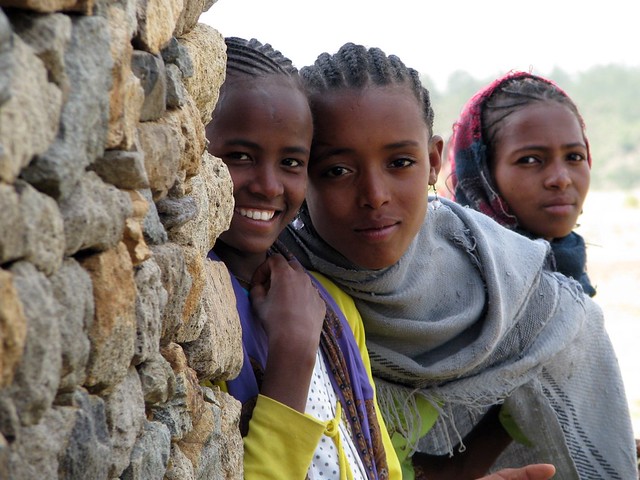
History
Historically, the province of Tigray and central Eritrea was where Ethiopian and Eritrean civilization had its origins. The first kingdom to arise was that of D`mt in the 8th century BC. The Aksumite Kingdom, one of the powerful civilizations of the ancient world, was centered there from at least 400 BC to the 10th century AD. Spreading far beyond modern Eritrea and Tigray, it moulded the earliest culture of Eritrea and Ethiopia and left many historical treasures: towering finely carved stelae, the remains of extensive palaces, and the ancient places of worship still vibrant with culture and pageantry.
The Tigray-Tigrinya people are descendants of early Semitic-speaking peoples whose presence in the region spanning central Eritrea and northern Ethiopia, is postulated to have existed from at least 2000 BC, based on linguistic evidence (and known from the 9th century BC from inscriptions)
According to Ethiopian traditions, the Tigrayan nobility; i.e. that of the Tigray province of Ethiopia, trace their ancestry to the legendary king Menelik I, the child born of the queen of Sheba and King Solomon as do the priests of the Ethiopian Orthodox Tewahedo Church (Ge'ez ካህን kāhin). Menelik I would become the first king of the Solomonic line of rulers of Ethiopia that ended only with the deposing of Emperor Haile Selassie in 1974.

The first possible mention of the group dates from around the 8th to 10th centuries, in which period manuscripts preserving the inscriptions of Cosmas Cosmas Indicopleustes (fl. 6th century) contain notes on his writings including the mention of a tribe called Tigretes. This writing clearly proves that the Tigray have been in their present location since before the time of Christ and began converting to Christianity in the fourth century. Some of the population may have migrated from the Arabian peninsula. There seems to be a long-term process of migration south, with Tigray imperceptibly "becoming" Amhara as they marry into Amhara communities. The Tigray, with the Amhara, are the coinheritors of the Aksumite Kingdom, which later become the Ethiopian Empire. Tigray as well as Amhara were eligible for the emperorship, the last Tigray emperor being Yohannes (1872-1889).
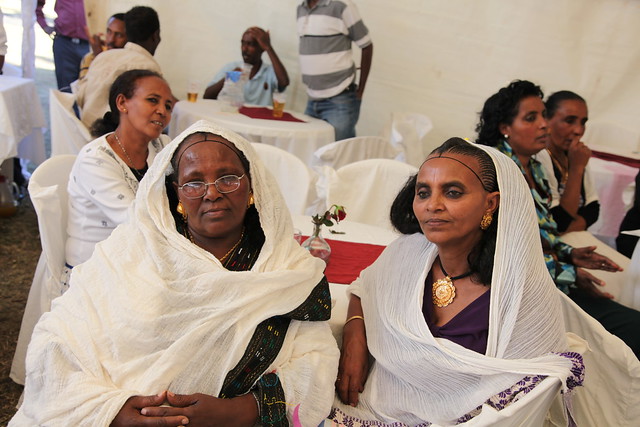
The Tigray living in Tigray Province experienced a relatively short colonial period (1936-1942) compared to that of their Eritrean neighbors, who were dominated by the Italians from the 1890s until 1942. The heavily Tigray-influenced Eritrean Liberation Front (ELF, now the EPLF) led a separatist revolt through the 1960s until it was joined by the now-stronger Tigray People's Liberation Front (TPLF) after the 1974 overthrow of Haile Selassie. Most Tigray are rural; Asmara in Eritrea and Maqelle in Tigray are the only urban centers. War, drought, and international relief agencies have played a major role in this region since the mid-1970s.
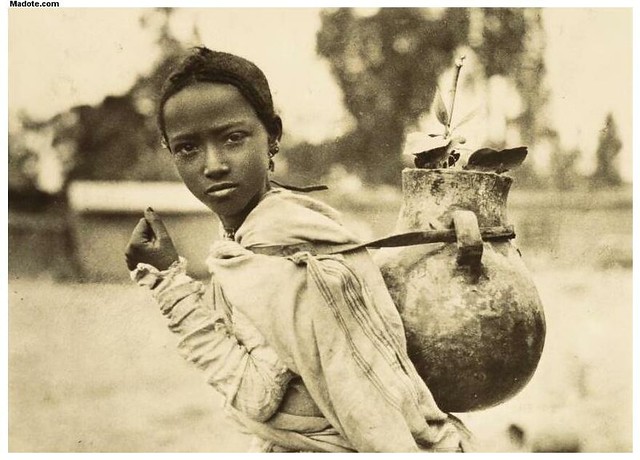
Young Eritrean girl from Kebessa - 1936
Settlements
Tigray "parishes" equate with local communities and are the smallest units of administration for both the state and the Ethiopian Orthodox church, having a chief appointed from above. Priests and deacons are responsible to church authorities. Parishes range in population from 500 to 4,000 people. There is regional variation in settlement pattern: climatic conditions favor dispersed settlement of small hamlets across parishes where rainfall is relatively constant from year to year, and nucleated villages, one per parish, where rainfall is less predictable. Villages go through a process of dividing into quarters, which reunite when new, more powerful quarters try to dominate them. Depending on the phase of their life cycle, villages have two or three quarters. Houses range from wattle-and-daub huts to impressive masonry lime-domed or zinc-corrugated roofed edifices, depending on the family's economic success.

Holly wood Stars Will Smith and his wife Jada Pinkett Smith were welcomed by Tigray people to Tigrai state in Ethiopia.
Economy
Subsistence and Commercial Activity. The Tigray practice plow cultivation of primarily cereal crops: wheat, barley, t'af (Amharic: tyeff; Eragrostis abyssinica ), and sorghum. A second crop per year is risky or impossible in most areas. Legumes, primarily garbanzos, are included in the croprotation cycle. After several years, weeds become too strong for competition, and the field is fallowed until grasses choke out the weeds and the turf can be removed again, bringing the field into cultivation. Flax is grown for linseed oil.

In some zones, frankincense figures prominently. For those living near the eastern escarpment, transportation of salt from the Danakil Depression for sale in the highland markets is an important source of income. In addition to the salt trade, individuals earn some cash by purchasing cattle and small animals in the lowlands and selling them further into the highlands. Cattle are important as plow animals. When population density is high and pasturage is in short supply, plow animals are the most critical variable in the agricultural process.

Industrial Arts. Crafts are associated with pariah "castes" of artisans who are believed to be witches. Blacksmithing, pottery making, tanning, weaving, and music making fall under this stigma. A person with a physical disability, however, can engage in weaving without being regarded as a witch.
Trade. Markets, shops, and mills are associated with towns. Shops are often run by Arab merchants. Products of artisanry (pottery, hides, metal tools), herbs and spices, coffee, salt, and bread are sold. Towns, especially those associated with administrative offices, have mead houses; each quarter of a village has at least one beer house.
Division of Labor
For nonartisans, sex and age account for most of the division of labor. Men are responsible for nearly all agriculture and husbandry. The sole exception is weeding, which is done by women. Once the grain has left the threshing floor, its storage and processing into injera (the crepelike staple) and bread is also the province of women. Boys, after the age of about 12, begin herding and helping with plowing and planting. Girls help with food preparation and child care. At least one herd boy is needed if a household is to be independent. If there are more herd boys than necessary, some may go off to study the Bible to prepare for careers as deacons, with the eventual possibility of joining the priesthood. Priests, like other male heads of households, are farmers. As many as 10 percent of a parish's households may be headed by priests. Most curing, which depends heavily on ecclesiastical training, is done by defrocked priests and deacons; most treatment of spirit possession is done by women. Artisans sometimes form their own villages, where they also practice agriculture; however, in other villages, they are found interspersed in individual households with nonartisans. Elders and powerful men are designated as "recognized men" and "big-men."
Land Tenure
Land tenure is complex and governed on a parish-by-parish basis. Each parish chooses from permutations of two basic forms: ristî (hereditary) and igurafgotet (communal). To make a claim under ristî, a person must trace descent from a parish founder through any combination of males and females. The system has inherent contradictions: all plots of land potentially have multiple claimants, giving rise to a political as well as a genealogical component to land claims. igurafgotet land tenure, unlike ristî—which can be used to restrict the inflow of new farmers—encourages newcomers and becomes salient after a drought depopulates an area. Because the choice of land-tenure systems affects the size of the holdings of many people, parishes switch from one system to the other only under extreme ecological and demographic conditions. The two land-tenure systems are not associated with settlement patterns; nucleated and dispersed forms of settlement are found with both types.

Kinship
Kin Groups and Descent. Descent is omnilineal or ambilineal. Descent groups form and disperse depending upon the particular land claim that is being prosecuted. Persons who are allies for one purpose are enemies for another. This does not follow the familiar pattern of "fission and fusion" described by Evans-Pritchard for the Nuer ( 1940), in that groups are not segments of larger groups but are based on a particular individual's genealogical relations in a particular parish. He or she will be brought together with a distinct collection of people in each parish and at each genealogical level. These associations do not achieve the kind of solidarity that would make them useful for purposes other than land claims. Kinship is bilateral and, like descent, is traced through any combination of males and females. The importance to each household of having at least one herd boy leads to boys often being brought up in the household of a father's or mother's brother or sister, as adjustments to household work forces require.
Kinship Terminology. Tigray kin terms reflect their bilateral kinship and omnilineal descent. Generation and linealtty are distinguished. Sex is distinguished only in Ego's generation and for parents. Kin types are grouped as follows: son and daughter, brother, sister, father, mother, father's and mother's brother, father's and mother's sister, and father's and and mother's father and mother. All eight great-grandparents are referred to by a single term.

Eritrea Tigrinya mothers
Marriage and Family
Marriage. Marriages are monogamous and "contractual." First marriages involve a dowry, usually of animals, given by the bride's family to the couple. Second marriages usually require equal contributions from both parties.

Should the potential wife not have capital comparable to her potential husband's, an arrangement is made in which she is "paid" and her accumulated shares are eventually converted into community property. Only older couples and deacons intending to become priests are married before the church.

The "life expectancy" of a marriage at the time it is contracted is between seven and twelve years. Marriage contracts incorporate the potential of divorce. At marriage, a guardian is selected to help reconcile difficulties and to aid in division of property in case of divorce. Elders are called in to oversee the process. After the wedding, for a first marriage, there is a period of bride-service during which the couple goes back and forth between the two parental households, spending time in each. Once bride-service has been completed, there is no formal rule of postmarital residence. Practical considerations of joint herding often lead to a period of viripatrilocal residence.

Domestic Unit. The nuclear family is the most common domestic unit. Youngest children may remain with the family homestead to take care of aging parents. A small number of economically successful households retain their own sons and daughters and draw in their mates, thus forming large multifamily households. Partition takes place in stages: separation of hearths, separation of grain bins, and final separation.
Inheritance. Inheritance rules distinguish between land and household property. If the parish is ristî, each child, regardless of gender or marital status, inherits an equal share of the land of his or her dead parent. Domestic equipment tends to remain with the child who took care of the aging parent. Other property (principally livestock), if not consumed in the funeral commemoration a year after death, may be divided.
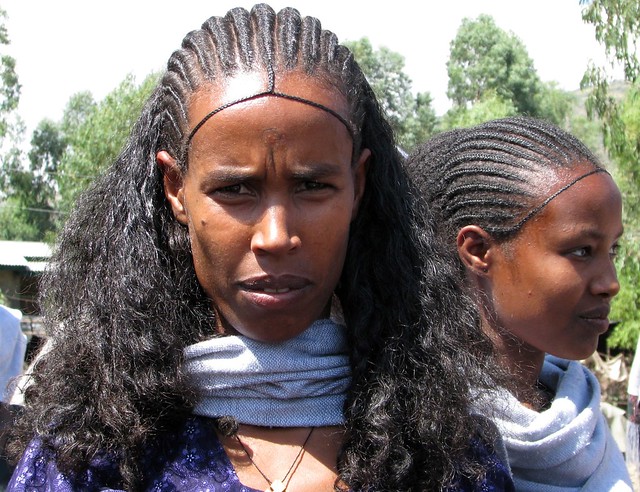
Socialization. Small children are indulged, particularly boys. Girls begin helping their mothers earlier than boys begin helping their fathers. Girls gradually take on domestic chores. At about age 7, boys must begin to learn to obey, which involves a period of apparent trauma. Children are baptized. A series of vertical scars to the outside of either eye, found on most adults, is regarded as "medicinal" rather than "ritual" and is done on the occasion of eye infections.

A cross is often made by tattoo or scarification in the middle of the forehead. Movement from minority to adulthood is not dramatic. Boys move to the adult part of the parish meeting when they become married or when they become deacons. Women tend to act in political contexts only in the absence of their husbands but have the rights of jural majors after marriage.

Sociopolitical Organization
Social Organization. The most significant unit beyond the household is the h'agareseb (lit., "farm people"), which is the parish or local community. It is at the parish meeting, held on Sunday mornings after church services, that all important community decisions are made, whether they be religious or civil, whether to add a new saint to the local church calendar or to repair a path. Parish meetings are presided over by a secular community leader, or "manager." In nucleated parishes, village wards are significant and have informal leaders. Neighbors participate in one another's life-cycle ceremonies and have the legal duty to respond when a neighbor raises a hue and cry. Descent groups have little relevance outside of land-tenure issues. Most adults belong to "twelve apostle" eating clubs, consisting of men or women or couples who meet once a month for feasting and discussion.

Political Organization. When the Ethiopian state was functioning well, the Tigray of Tigray Province were full participants in politcal life and on several occasions provided emperors. This relationship was interrupted in Eritrea by the long Italian colonization. After the 1974 Revolution, many of the Tigray in both areas rose in rebellion. Nowadays the state organization involves provincial, district, and subdistrict governors. Each parish has an official, appointed from above, who owes loyalty to the subdistrict governor. The official at each level of government owes loyalty to the official immediately above him, not to the central government. Parish priests are responsible to the bishops.
Social Control. In native theory, people are "good" because they fear what their neighbors will think, what the courts will do, and what God will do. Beyond this, the parish chief is an officer of the court and has the responsibility to handle minor cases and to carry more serious ones to higher courts. The institution of awu ha h requires all members of the community to assemble for three days or until someone confesses knowledge of a crime.
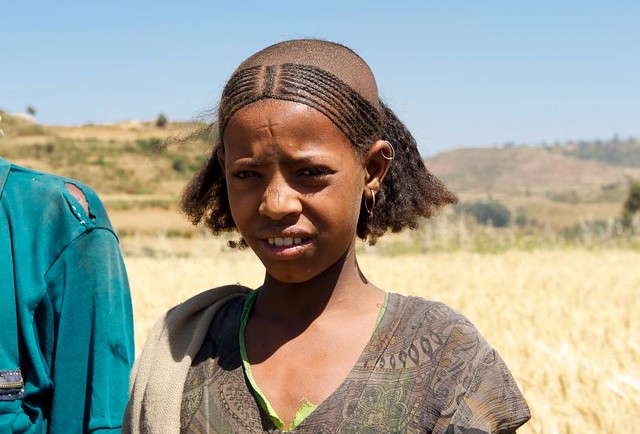
Young Tigray girl in a field with her traditional hairstyle. Tigray. Ethiopia
Conflict. The Tigray see conflict as a natural consequence of weak authority. Conflicts occasionally transpire, ranging from those at the the intervillage level to rebellions against the state, as happened in the 1940s and again since the Revolution. Outlaws with a large following are sometimes later made part of the state, and state officials sometimes become outlaws.

Tigray woman from Ethiopia
Religious belief
The Tigray recognized three categories of belief as "religion" (haymanot): Christianity, Islam, and Judaism. In Ethiopia, the Tigray Region is 95.6% Ethiopian Orthodox, 4% Muslim, and the remaining 0.4% are mostly Catholic and Protestant. In Eritrea, the Jeberti are Muslim and account for about 10% of the Tigrinya people there. The remaining 90% are Christians, so divided: 73% of the Eritrean Orthodox faith, 10% Roman Catholic and Eastern Catholic (whose mass is held in Ge'ez as opposed to Latin), and 7% belonging to various Protestant and other Christian denominations, the majority of which belong to the (Lutheran) Evangelical Church of Eritrea.
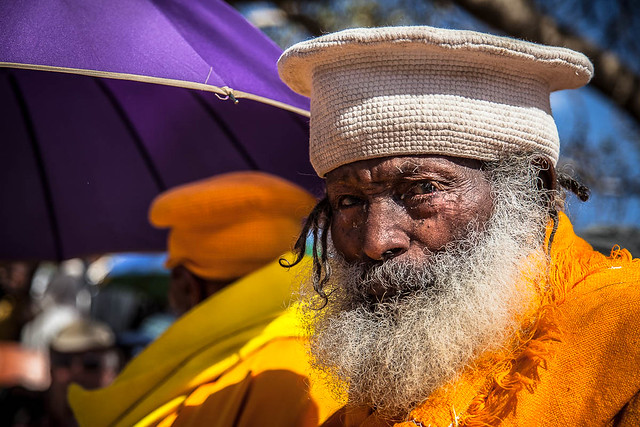 These are the government registered (allowed) religions of Eritrea. Meanwhile there are those who profess faith to smaller Evangelical denominations whose rights to worship are currently suspended by the Eritrean government, such as the Pentecostals, Seventh Day Adventists, Jehovah's Witnesses as well as non Christian denominations such as the Bahá'í.
These are the government registered (allowed) religions of Eritrea. Meanwhile there are those who profess faith to smaller Evangelical denominations whose rights to worship are currently suspended by the Eritrean government, such as the Pentecostals, Seventh Day Adventists, Jehovah's Witnesses as well as non Christian denominations such as the Bahá'í.

A number of the saints are indigenous and not shared by the Roman or Greek churches. Spirit possession, in the form of the zar cult, is prominent, but many Tigray regard it as illegitimate. Zar has special significance in empowering women.
Christianity is said to have come to Tigray with the shipwrecked Syrian Fromentius, in the third century. Each parish is associated with a church, which in most regions is built of masonry and, in some others, carved into cliffs. It is through Bible study that most young men gain literacy. The Ethiopian Orthodox church was formally affiliated with the Coptic church in Alexandria, to which, until 1954, it was obliged to turn for archbishops.

The Ethiopian and Eritrean Orthodox Churches trace their roots back to the Axumite Church founded in the 4th century by Syrian monks. Historically, the Ethiopian and Eritrean churches have had strong ties with the Egyptian Coptic church, where the Egyptian Church appointed the Abuna (archbishop) for the Ethiopian Church (which then incorporated Eritrea) until 1959. The Ethiopian Church gained independence from the Coptic church in 1948 and began anointing its own pope. The Eritrean Orthodox church split from the Ethiopian Orthodox in 1993 and reverted to having its pope in the Coptic Church of Alexandria, Egypt.

A small crowd waiting outside S. Salvatore in Campo for the final part of Michaelmas
Over 6 million Tigrayans are Oriental Orthodox, with one priest for every 92 members—the highest concentration in Ethiopia. The remainder are Muslims. There are many Muslims in Tigray Province, but they generally belong to other ethnic groups than the Tigrayans. The Tigrayans are reported to have fewer than 500 Evangelicals, but there are more Evangelicals among the Tigrinya in Eritrea.
The faith of the church is very intimately woven into the culture of the Christian members of the Tigrinya people and is central to their way of life. In the Ethiopian and Eritrean Orthodox and Catholic churches, Mary is considered a saint, and the Ark of the Covenant (tabot) features prominently in the Orthodox Church. Moreover, the Ge'ez bible preserves many texts considered apocryphal by Catholics, Orthodox, and Protestants, such as 1 Enoch, which has only been preserved in Ge'ez.

Church services are conducted in Ge'ez, the ancient language of Ethiopia and Eritrea, just as Latin once was in the Roman Catholic Church, and continues to be the liturgical language.
The Eastern Catholic Church in Eritrea was established in the 16th century by Portuguese and Spanish missionaries who had come to help the Christian Abyssinians fight off a Turkish invasion. Centered in the former Akele Guzai province (the eastern part of the Eritrean highlands) the churches maintained most of the liturgy of the already existing Orthodox Church, including Ge'ez as the liturgical language, with minor differences there-among sharing communion with, and submitting to the authority of the Vatican Pope as opposed to the Pope in Axum.
Roman Catholicism arrived in Eritrea with the advent of Italian colonialism and almost coincided with the arrival of Swedish missionaries who brought Lutheran Christianity to Eritrea at the end of the 19th century. The relationship between these two religions was especially tense as the Roman Catholic Italians resisted and discouraged the spread of Protestantism in their colony and even lay prohibitions and numerous constraints on the activities of the Swedish missionaries. The Roman Catholic Church as an instrument of the colonial authority has held mass in Latin and Italian since its inception, incorporating local languages in its missionary work throughout Eritrea. It initially sought to cater to Italian citizens as well as foster an elite of Eritreans into becoming good Italian subjects. Today the church is a distinctly Eritrean church, although masses continue to be held in Italian and Latin along with local languages there-among Tigrinya and it also caters to the very small Italian and Italo-Eritrean community mainly in Asmara. The Lutheran Church of Eritrea and its Swedish and Eritrean missionaries were the ones who translated the Bible from the dead Ge'ez language only understood by higher clergymen, into the Tigrinya and other local languages and their main goal was to reach and "enlighten" as many people as possible in the world through education. They were instrumental in raising the literacy rate of their community.

Religious Practitioners
Priests and deacons, many monastery trained, celebrate the Mass. Diviners are defrocked deacons or priests. Spirit mediums are typically women, as are the vast majority of those afflicted with possession.

Priests and deacons receive a special allotment of land for their services, plus honoraria from their penitents. Diviners charge for their services, as do spirit mediums.

Ceremonies
The most frequent ceremony is the celebration of Mass, which occurs a number of times per week, depending on the local church calendar and parish patron saints. Other important rituals are baptism and funerals. Ordinary weddings are more ceremonial than ritual. Divination and curing have a ritual character, as do ward or neighborhood dances intended to affect the weather.

Ashenda Holidays dance. Three days of women! Ashenda is a holiday celebrating women here in Northern Ethiopia mostly in the Tigray region. It corresponds to the end of a two week fasting period for Ethiopian Orthodox Christians commemorating the Virgin Mary, but the holiday has grown way beyond that now.
Arts.
Arts, crafts, and secular music are primarily the domain of the pariah castes of artisans. The exceptions are sacred music, which is led by monastically trained (but not necessarily ordained) men, and icon painting, biblical illumination, and scroll making, which are undertaken by a few deacons.

Medicine
Most affliction (including illness) is treated by diviners rather than by priests or spirit mediums. Affliction is attributed to transgressions against God, sorcery motivated by envy, or witchcraft unconsciously executed by artisans or others possessed by Satan. Diviners both diagnose and treat. Spirit possession by entities other than Satan and his minions primarily affects women and is regarded as outside the realm of Christian belief. Such possession may be brought under control but not cured.
Death and Afterlife
After death, people are judged, in what is popularly thought of as a setting much like a secular court, and proceed to heaven or hell.
 Source: http://www.encyclopedia.com/topic/Tigray.aspx
Source: http://www.encyclopedia.com/topic/Tigray.aspx
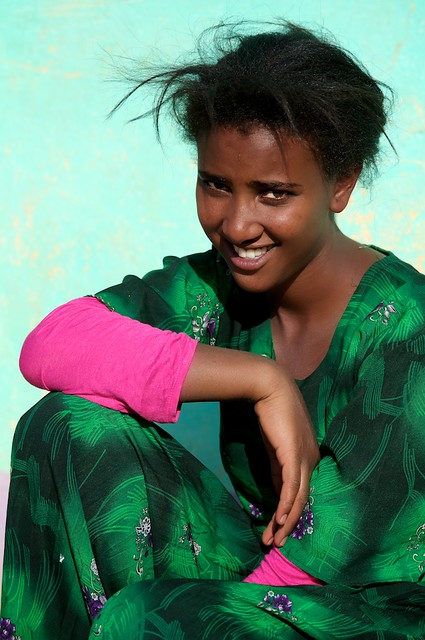

The ancestors of the Tigrinya people
Written By Admin of madote.com on Aug 1, 2013
The Tigrinya people, who are also known as the Kebessa people, are the largest ethnic group in Eritrea. They speak Tigrinya, a Semetic language derived from Ge'ez, and largely inhabit the plateau of the country. Because of their language and script (Fidel), many colonial-era scholars assumed Tigrinya people were of a mixed Yemeni (Sabaean) and Eritrean origin. Despite lacking evidence for this claim, this narrative still persists today, albeit waning.

The ancestors of the Tigrinya people, and other groups within the Horn of Africa, adopted South Arabian derived languages, not because they were mixed with Sabaeans or colonized by them, but because they were "within the orbit of Sabaean economic and religious spheres of influence, and local African elites likely used symbolic materials to signal "Sabaean" identity for reasons of social differentiation, but the seeds of urbanism and local industry were planted locally long before.
Professor Peter R. Schmidt also adds:
"Pre-Aksumite" incorporation of such elements may have taken place over many generations rather than being the products of a limited number of South Arabian colonization or migration events, nor do they signify a dominant vs. subordinate or core vs. periphery relationship between polities. Elites of peer polities or co-evolving polities of relative parity in sociopolitical development and economy may actively appropriate symbols and objects from one another for use in internal legitimization. This is a view of active engagement and critical selection from a diverse repertoire of elements in the southern Red Sea cultural milieu, not a passive incorporation from colonizing populations; it is a perspective that promotes "Pre-Aksumite" agency and creates a more dynamic picture of cultural transformation in the 1st millennium BCE."
[To give a related example, king Zoscales of Adulis, who ruled in the 1st century CE, was known to speak and write in Greek. In fact, Hellenic influences on the region were so strong that nearly all inscriptions until the early 4th century CE were made in Greek. The elite inhabitants of the region adopted Greek for the same reasons they adopted Sabaean material culture: because they were within the economic and cultural influences of these polities. Additionally, by connecting themselves with foreign kingdoms and empires, the elites were seeking to legitimize their rule domestically.
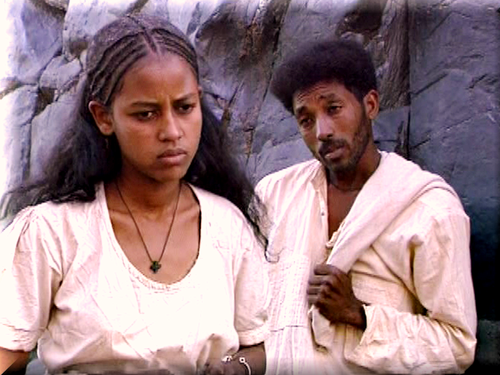.png)
So who are the ancestors of the Tigrinya people?
Although our knowledge of ancient Eritrea is still in its infancy, the archaeological remains found in the plateaus around Asmara indicate a pastoralist society (with some limited agriculture capacity) was inhabiting the region in the 2nd millennium BCE. These early groups of people produced Black Ware pottery, which have historically been associated with the Beja people.
"Around 2,000 B.C. pastoral people from the deserts of southern Egypt and northern Sudan entered the Barka Valley and northern highlands, pushing the first wave southwards. These people were the forerunners of the Beja tribes, who for many hundreds of years seem to have been the only independent pastoralists in Africa."




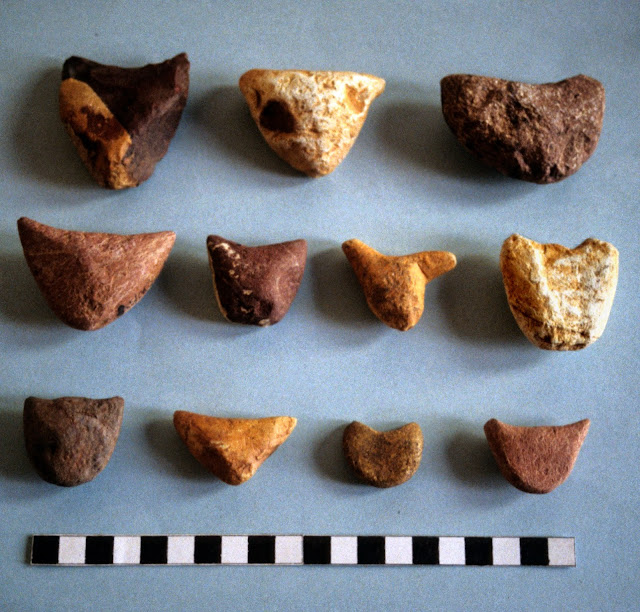
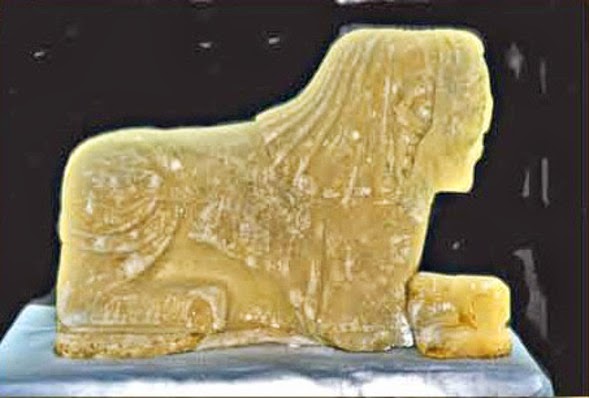
Biher-Tigrinya and Tigray people: The war of Identities









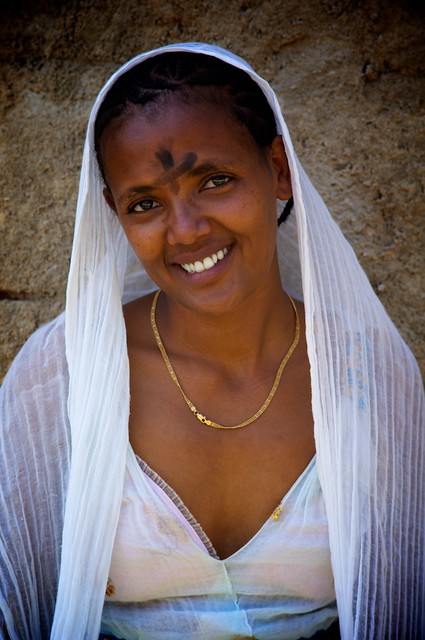



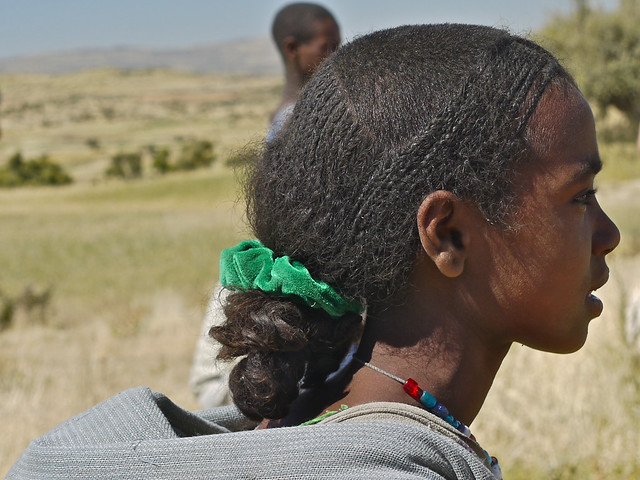



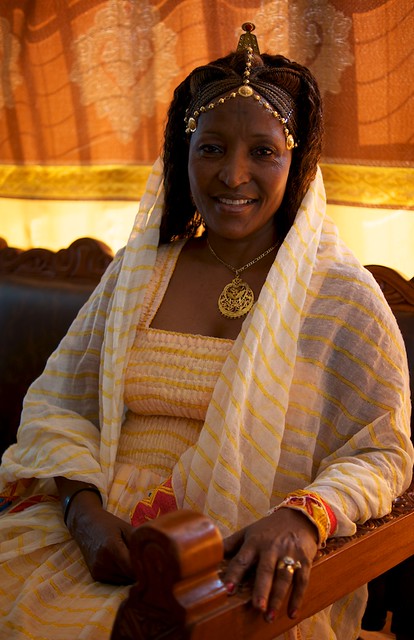
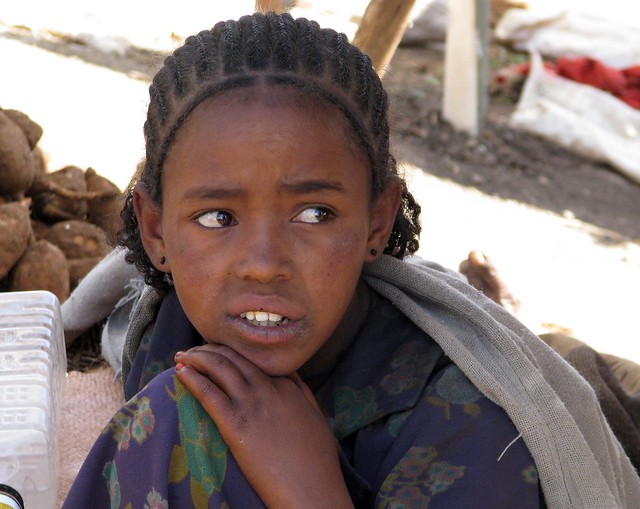



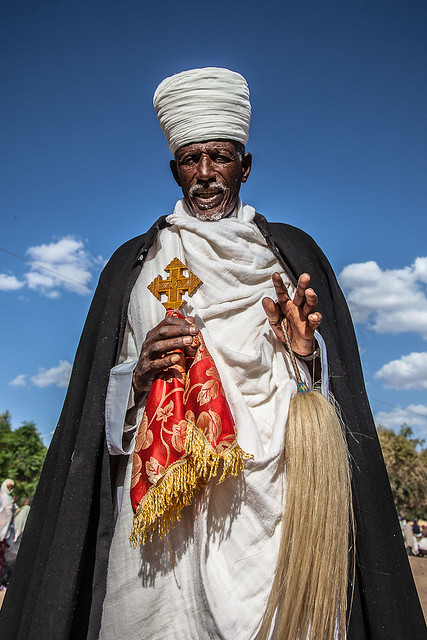



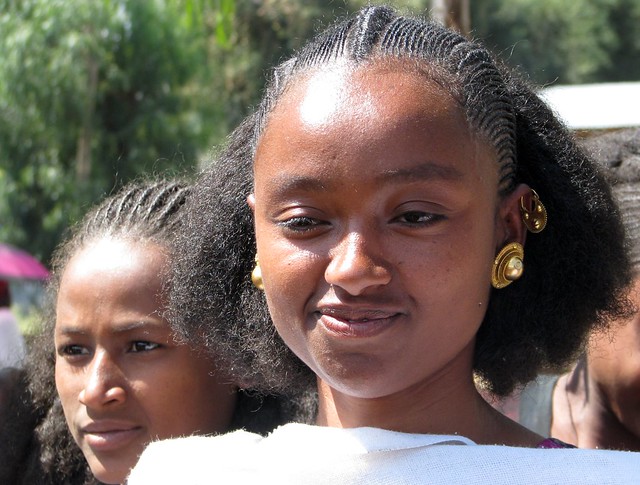

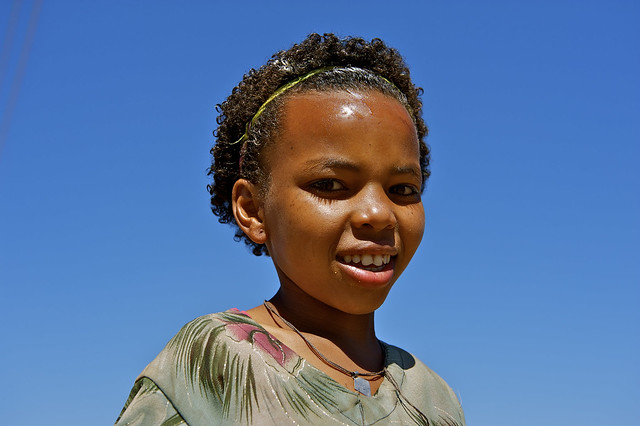









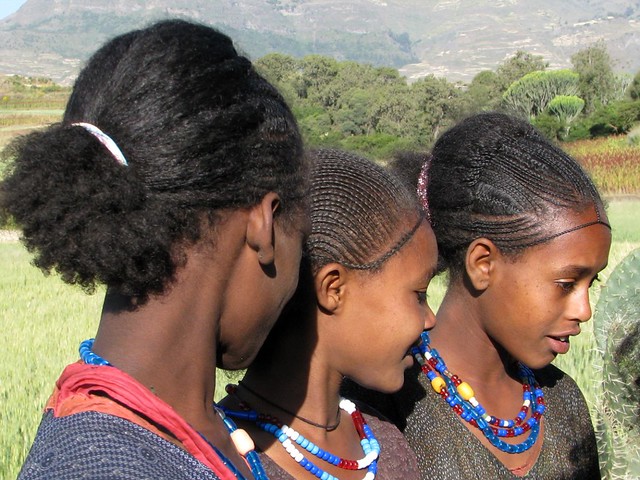
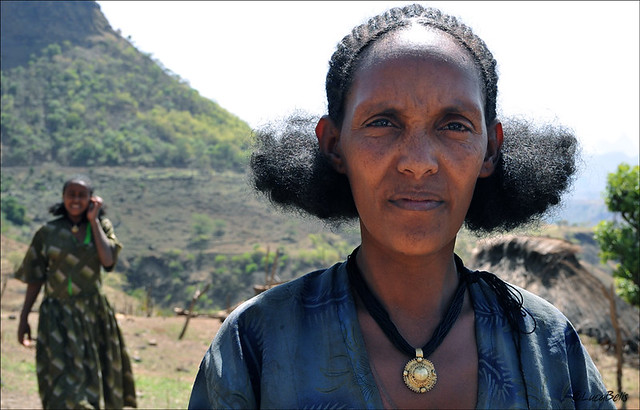



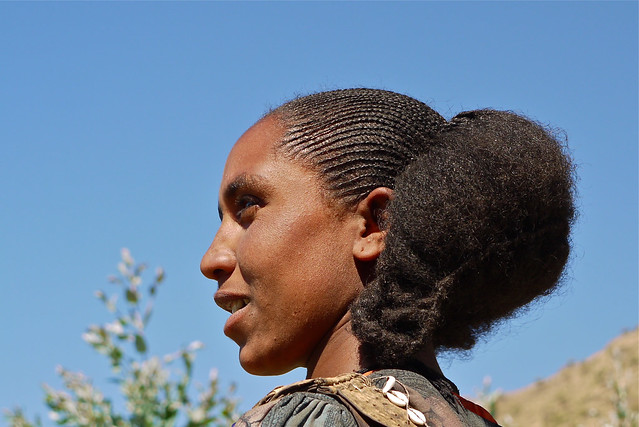



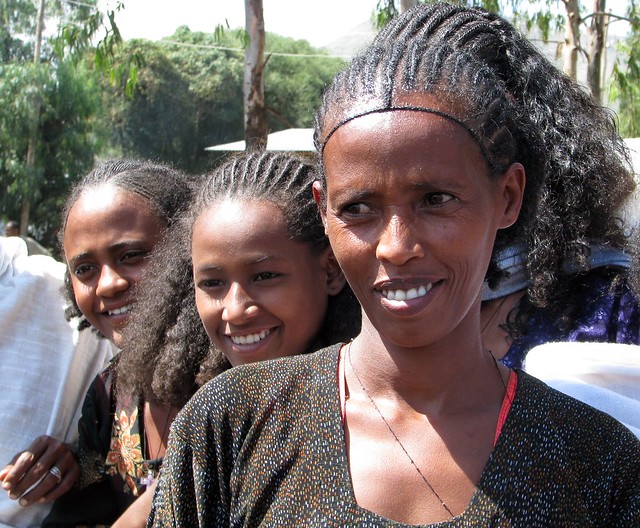








Tigrinya people at their traditional wedding at Asmara, Eritrea
The Tigray-Tigrinya shares common ancestral imperial heritage with the Amhara people of Ethiopia and the two together built the powerful ancient Kingdom of Aksum in Ethiopia. Though, the seat of the ancient Aksumite Kingdom resided in Tigray territory, but the Tigray have not been as thoroughly studied as their culturally similar neighbors, the Amhara.
Tigray people of Ethiopia
In Ethiopia, prior to 1995, Tigray-Tigrinya lived in the former provinces of Tigray, Begemder (Gonder), and Wollo, with the regions within these provinces that they inhabited (e.g. Wolqayt, Tsegede, Tselemti, Raya, Humera) later incorporated into the modern Tigray Region. The Tigray people, eponymous with the name of their territory, make up approximately 96.6% of the inhabitants of the Tigray Region, and comprise 6.1% of Ethiopia's total population, numbering a little over 5.7 million.
Tigray girl in a small village near Mekele, Northern Ethiopia. This young girl was very proud of her small makeup kit and started to paint her eyes in the door light. Courtesy http://ngm.nationalgeographic.com/
In in Eritrea where they are the largest ethnic group, the Tigrays are simply known by the name of their language, as the Tigrinya. Officially and collectively they are also referred to as the Biher-Tigrinya, roughly meaning "Tigrinya nation". Since they primarily lived in a region of Eritrea known as the Kebessa, which was within the former awrajas of Hamasien, Seraye, and Akele Guzay, and are now incorporated into Eritrea's present-day regions, they are also called Kebessa people. Most of them live in rural areas in the highland administrative regions of Maekel (Central), Debub (Southern), the eastern fringes of Anseba and Gash Barka regions as well as the western fringes of Semenawi Keyih Bahri (Northern Red Sea). They are small holding farmers largely inhabiting small communal villages. The Tigrinya constitute around 50% of the Eritrean population, at about 3.4 million people.
Tigray-Tigrinya ladies
It must be emphasized, however, that a significant number of Muslim Tigrinya speakers refuse to identify themselves as Tigrinya and consequently constitute a separate ethnic group known as the Jeberti. These Jeberti people trace their origins in early Muslim migrants from the Arabian Peninsula to Tigray; they make up about 5% of the Eritrean population.
Asmara, as well as Mendefera, Dekemhare, Segeneiti, Adi Keyh, Adi Quala and Senafe. There is also a significant population of Biher-Tigrinya in other cities, including Keren and Massawa.
Tigrinya man from Asmara
Geography and Climate
The terrain is high plateau, cut through by deep ravines. Nearly all the land is either under cultivation or in pasturage, although reserved areas that surround churches suggest that the climax growth of much of Tigray is cedar forest.
The average annual rainfall hovers around the 50 centimeters required for cereal agriculture. Droughts are frequent. Rainfall concentrates in two periods: the "large rains" fall for three months beginning in mid-June and the "small rains"—if they come—fall in January or February. Most Tigray live in the highlands, where daytime high temperatures are relatively cool (21° to 27° C); nighttime temperatures occasionally plunge below freezing in December.
Beautiful Ashenda girls in Tigrai state Northern Ethiopia Ashenda is a unique beautiful Tigraian traditional festival where young ladies and girls enjoy Ashenda music
Language
The mother tongue of the Tigray-Tigrinya is the Tigrinya language or Tigrigna or simply as Tigray. Tigrinya language belongs to the Ethiopian Semitic sub-group of the the larger Afro-Asiatic language family. Tigrinya is descended from an ancient Semitic language called Ge'ez, which the modern Ethiopian and Eritrean Orthodox Churches officially use as a liturgical language. The Tigrinya language is the direct descendant of Ge'ez, unlike Amharic (thought to be descended from a specific dialect or cluster of dialects of Ge'ez) and other southern Ethiopian Semitic languages, though Tigre may share this distinction with Tigrinya (its status is uncertain).

Eritrean Tigrinya woman with her traditional hairstyle, Asmara, Eritrea
Tigrinya is closely related to the Tigre language, another Afro-Asiatic language spoken by the Tigre people as well as many Beja. Tigrinya and Tigre although close are not mutually intelligible, and while Tigrinya has traditionally been written using the same Ge'ez script (fidel) as Amharic, Tigre has been transcribed mainly using the Arabic script. Attempts by the Eritrean government to have Tigre written using the Ge'ez script has met with some resistance from the predominantly Muslim Tigre people who associate Ge'ez with the Orthodox Church and would prefer the Arabic or the more neutral Latin alphabet.

Holly wood Stars Will Smith and his wife Jada Pinkett Smith wearing traditional dress of Tigray people in Tigrai state in Ethiopia.
It has also met with the linguistic difficulty of the Ge'ez script being a syllabic system which does not distinguish long vowels from short ones. While this works well for writing Tigrinya or Amharic, which do not rely on vowel length in words, it does complicate writing Tigre, where vowel length sometimes distinguishes one word and its meaning from another. The Ge'ez script evolved from the Epigraphic South Arabian script, whose first inscriptions are from the 8th century BC in Eritrea, Ethiopia and Yemen.
| ä | u | i | a | e | (ə) | o | wä | wi | wa | we | wə | ||
|---|---|---|---|---|---|---|---|---|---|---|---|---|---|
| h | ሀ | ሁ | ሂ | ሃ | ሄ | ህ | ሆ | ||||||
| l | ለ | ሉ | ሊ | ላ | ሌ | ል | ሎ | ||||||
| ḥ | ሐ | ሑ | ሒ | ሓ | ሔ | ሕ | ሖ | ||||||
| m | መ | ሙ | ሚ | ማ | ሜ | ም | ሞ | ||||||
| ś | ሠ | ሡ | ሢ | ሣ | ሤ | ሥ | ሦ | ||||||
| r | ረ | ሩ | ሪ | ራ | ሬ | ር | ሮ | ||||||
| s | ሰ | ሱ | ሲ | ሳ | ሴ | ስ | ሶ | ||||||
| š | ሸ | ሹ | ሺ | ሻ | ሼ | ሽ | ሾ | ||||||
| ḳ | ቀ | ቁ | ቂ | ቃ | ቄ | ቅ | ቆ | ቈ | ቊ | ቋ | ቌ | ቍ | |
| ḳʰ | ቐ | ቑ | ቒ | ቓ | ቔ | ቕ | ቖ | ቘ | ቚ | ቛ | ቜ | ቝ | |
| b | በ | ቡ | ቢ | ባ | ቤ | ብ | ቦ | ||||||
| v | ቨ | ቩ | ቪ | ቫ | ቬ | ቭ | ቮ | ||||||
| t | ተ | ቱ | ቲ | ታ | ቴ | ት | ቶ | ||||||
| č | ቸ | ቹ | ቺ | ቻ | ቼ | ች | ቾ | ||||||
| ḫ | ኀ | ኁ | ኂ | ኃ | ኄ | ኅ | ኆ | ኈ | ኊ | ኋ | ኌ | ኍ | |
| n | ነ | ኑ | ኒ | ና | ኔ | ን | ኖ | ||||||
| ñ | ኘ | ኙ | ኚ | ኛ | ኜ | ኝ | ኞ | ||||||
| ʾ | አ | ኡ | ኢ | ኣ | ኤ | እ | ኦ | ||||||
| k | ከ | ኩ | ኪ | ካ | ኬ | ክ | ኮ | ኰ | ኲ | ኳ | ኴ | ኵ | |
| x | ኸ | ኹ | ኺ | ኻ | ኼ | ኽ | ኾ | ዀ | ዂ | ዃ | ዄ | ዅ | |
| w | ወ | ዉ | ዊ | ዋ | ዌ | ው | ዎ | ||||||
| ʿ | ዐ | ዑ | ዒ | ዓ | ዔ | ዕ | ዖ | ||||||
| z | ዘ | ዙ | ዚ | ዛ | ዜ | ዝ | ዞ | ||||||
| ž | ዠ | ዡ | ዢ | ዣ | ዤ | ዥ | ዦ | ||||||
| y | የ | ዩ | ዪ | ያ | ዬ | ይ | ዮ | ||||||
| d | ደ | ዱ | ዲ | ዳ | ዴ | ድ | ዶ | ||||||
| ǧ | ጀ | ጁ | ጂ | ጃ | ጄ | ጅ | ጆ | ||||||
| g | ገ | ጉ | ጊ | ጋ | ጌ | ግ | ጎ | ጐ | ጒ | ጓ | ጔ | ጕ | |
| ṭ | ጠ | ጡ | ጢ | ጣ | ጤ | ጥ | ጦ | ||||||
| č̣ | ጨ | ጩ | ጪ | ጫ | ጬ | ጭ | ጮ | ||||||
| p̣ | ጰ | ጱ | ጲ | ጳ | ጴ | ጵ | ጶ | ||||||
| ṣ | ጸ | ጹ | ጺ | ጻ | ጼ | ጽ | ጾ | ||||||
| ṣ́ | ፀ | ፁ | ፂ | ፃ | ፄ | ፅ | ፆ | ||||||
| f | ፈ | ፉ | ፊ | ፋ | ፌ | ፍ | ፎ | ||||||
| p | ፐ | ፑ | ፒ | ፓ | ፔ | ፕ | ፖ | ||||||
| ä | u | i | a | e | (ə) | o | wä | wi | wa | we | wə | ||

History
Historically, the province of Tigray and central Eritrea was where Ethiopian and Eritrean civilization had its origins. The first kingdom to arise was that of D`mt in the 8th century BC. The Aksumite Kingdom, one of the powerful civilizations of the ancient world, was centered there from at least 400 BC to the 10th century AD. Spreading far beyond modern Eritrea and Tigray, it moulded the earliest culture of Eritrea and Ethiopia and left many historical treasures: towering finely carved stelae, the remains of extensive palaces, and the ancient places of worship still vibrant with culture and pageantry.
The Tigray-Tigrinya people are descendants of early Semitic-speaking peoples whose presence in the region spanning central Eritrea and northern Ethiopia, is postulated to have existed from at least 2000 BC, based on linguistic evidence (and known from the 9th century BC from inscriptions)
According to Ethiopian traditions, the Tigrayan nobility; i.e. that of the Tigray province of Ethiopia, trace their ancestry to the legendary king Menelik I, the child born of the queen of Sheba and King Solomon as do the priests of the Ethiopian Orthodox Tewahedo Church (Ge'ez ካህን kāhin). Menelik I would become the first king of the Solomonic line of rulers of Ethiopia that ended only with the deposing of Emperor Haile Selassie in 1974.
Tigrinya woman of Eritrea. Circa 1910
The first possible mention of the group dates from around the 8th to 10th centuries, in which period manuscripts preserving the inscriptions of Cosmas Cosmas Indicopleustes (fl. 6th century) contain notes on his writings including the mention of a tribe called Tigretes. This writing clearly proves that the Tigray have been in their present location since before the time of Christ and began converting to Christianity in the fourth century. Some of the population may have migrated from the Arabian peninsula. There seems to be a long-term process of migration south, with Tigray imperceptibly "becoming" Amhara as they marry into Amhara communities. The Tigray, with the Amhara, are the coinheritors of the Aksumite Kingdom, which later become the Ethiopian Empire. Tigray as well as Amhara were eligible for the emperorship, the last Tigray emperor being Yohannes (1872-1889).

The Tigray living in Tigray Province experienced a relatively short colonial period (1936-1942) compared to that of their Eritrean neighbors, who were dominated by the Italians from the 1890s until 1942. The heavily Tigray-influenced Eritrean Liberation Front (ELF, now the EPLF) led a separatist revolt through the 1960s until it was joined by the now-stronger Tigray People's Liberation Front (TPLF) after the 1974 overthrow of Haile Selassie. Most Tigray are rural; Asmara in Eritrea and Maqelle in Tigray are the only urban centers. War, drought, and international relief agencies have played a major role in this region since the mid-1970s.

Young Eritrean girl from Kebessa - 1936
Settlements
Tigray "parishes" equate with local communities and are the smallest units of administration for both the state and the Ethiopian Orthodox church, having a chief appointed from above. Priests and deacons are responsible to church authorities. Parishes range in population from 500 to 4,000 people. There is regional variation in settlement pattern: climatic conditions favor dispersed settlement of small hamlets across parishes where rainfall is relatively constant from year to year, and nucleated villages, one per parish, where rainfall is less predictable. Villages go through a process of dividing into quarters, which reunite when new, more powerful quarters try to dominate them. Depending on the phase of their life cycle, villages have two or three quarters. Houses range from wattle-and-daub huts to impressive masonry lime-domed or zinc-corrugated roofed edifices, depending on the family's economic success.
Holly wood Stars Will Smith and his wife Jada Pinkett Smith were welcomed by Tigray people to Tigrai state in Ethiopia.
Economy
Subsistence and Commercial Activity. The Tigray practice plow cultivation of primarily cereal crops: wheat, barley, t'af (Amharic: tyeff; Eragrostis abyssinica ), and sorghum. A second crop per year is risky or impossible in most areas. Legumes, primarily garbanzos, are included in the croprotation cycle. After several years, weeds become too strong for competition, and the field is fallowed until grasses choke out the weeds and the turf can be removed again, bringing the field into cultivation. Flax is grown for linseed oil.
In some zones, frankincense figures prominently. For those living near the eastern escarpment, transportation of salt from the Danakil Depression for sale in the highland markets is an important source of income. In addition to the salt trade, individuals earn some cash by purchasing cattle and small animals in the lowlands and selling them further into the highlands. Cattle are important as plow animals. When population density is high and pasturage is in short supply, plow animals are the most critical variable in the agricultural process.
Industrial Arts. Crafts are associated with pariah "castes" of artisans who are believed to be witches. Blacksmithing, pottery making, tanning, weaving, and music making fall under this stigma. A person with a physical disability, however, can engage in weaving without being regarded as a witch.
Trade. Markets, shops, and mills are associated with towns. Shops are often run by Arab merchants. Products of artisanry (pottery, hides, metal tools), herbs and spices, coffee, salt, and bread are sold. Towns, especially those associated with administrative offices, have mead houses; each quarter of a village has at least one beer house.
Division of Labor
For nonartisans, sex and age account for most of the division of labor. Men are responsible for nearly all agriculture and husbandry. The sole exception is weeding, which is done by women. Once the grain has left the threshing floor, its storage and processing into injera (the crepelike staple) and bread is also the province of women. Boys, after the age of about 12, begin herding and helping with plowing and planting. Girls help with food preparation and child care. At least one herd boy is needed if a household is to be independent. If there are more herd boys than necessary, some may go off to study the Bible to prepare for careers as deacons, with the eventual possibility of joining the priesthood. Priests, like other male heads of households, are farmers. As many as 10 percent of a parish's households may be headed by priests. Most curing, which depends heavily on ecclesiastical training, is done by defrocked priests and deacons; most treatment of spirit possession is done by women. Artisans sometimes form their own villages, where they also practice agriculture; however, in other villages, they are found interspersed in individual households with nonartisans. Elders and powerful men are designated as "recognized men" and "big-men."
Land Tenure
Land tenure is complex and governed on a parish-by-parish basis. Each parish chooses from permutations of two basic forms: ristî (hereditary) and igurafgotet (communal). To make a claim under ristî, a person must trace descent from a parish founder through any combination of males and females. The system has inherent contradictions: all plots of land potentially have multiple claimants, giving rise to a political as well as a genealogical component to land claims. igurafgotet land tenure, unlike ristî—which can be used to restrict the inflow of new farmers—encourages newcomers and becomes salient after a drought depopulates an area. Because the choice of land-tenure systems affects the size of the holdings of many people, parishes switch from one system to the other only under extreme ecological and demographic conditions. The two land-tenure systems are not associated with settlement patterns; nucleated and dispersed forms of settlement are found with both types.
Kinship
Kin Groups and Descent. Descent is omnilineal or ambilineal. Descent groups form and disperse depending upon the particular land claim that is being prosecuted. Persons who are allies for one purpose are enemies for another. This does not follow the familiar pattern of "fission and fusion" described by Evans-Pritchard for the Nuer ( 1940), in that groups are not segments of larger groups but are based on a particular individual's genealogical relations in a particular parish. He or she will be brought together with a distinct collection of people in each parish and at each genealogical level. These associations do not achieve the kind of solidarity that would make them useful for purposes other than land claims. Kinship is bilateral and, like descent, is traced through any combination of males and females. The importance to each household of having at least one herd boy leads to boys often being brought up in the household of a father's or mother's brother or sister, as adjustments to household work forces require.
Kinship Terminology. Tigray kin terms reflect their bilateral kinship and omnilineal descent. Generation and linealtty are distinguished. Sex is distinguished only in Ego's generation and for parents. Kin types are grouped as follows: son and daughter, brother, sister, father, mother, father's and mother's brother, father's and mother's sister, and father's and and mother's father and mother. All eight great-grandparents are referred to by a single term.
Eritrea Tigrinya mothers
Marriage and Family
Marriage. Marriages are monogamous and "contractual." First marriages involve a dowry, usually of animals, given by the bride's family to the couple. Second marriages usually require equal contributions from both parties.
Should the potential wife not have capital comparable to her potential husband's, an arrangement is made in which she is "paid" and her accumulated shares are eventually converted into community property. Only older couples and deacons intending to become priests are married before the church.
The "life expectancy" of a marriage at the time it is contracted is between seven and twelve years. Marriage contracts incorporate the potential of divorce. At marriage, a guardian is selected to help reconcile difficulties and to aid in division of property in case of divorce. Elders are called in to oversee the process. After the wedding, for a first marriage, there is a period of bride-service during which the couple goes back and forth between the two parental households, spending time in each. Once bride-service has been completed, there is no formal rule of postmarital residence. Practical considerations of joint herding often lead to a period of viripatrilocal residence.

Domestic Unit. The nuclear family is the most common domestic unit. Youngest children may remain with the family homestead to take care of aging parents. A small number of economically successful households retain their own sons and daughters and draw in their mates, thus forming large multifamily households. Partition takes place in stages: separation of hearths, separation of grain bins, and final separation.
Inheritance. Inheritance rules distinguish between land and household property. If the parish is ristî, each child, regardless of gender or marital status, inherits an equal share of the land of his or her dead parent. Domestic equipment tends to remain with the child who took care of the aging parent. Other property (principally livestock), if not consumed in the funeral commemoration a year after death, may be divided.

Socialization. Small children are indulged, particularly boys. Girls begin helping their mothers earlier than boys begin helping their fathers. Girls gradually take on domestic chores. At about age 7, boys must begin to learn to obey, which involves a period of apparent trauma. Children are baptized. A series of vertical scars to the outside of either eye, found on most adults, is regarded as "medicinal" rather than "ritual" and is done on the occasion of eye infections.
A cross is often made by tattoo or scarification in the middle of the forehead. Movement from minority to adulthood is not dramatic. Boys move to the adult part of the parish meeting when they become married or when they become deacons. Women tend to act in political contexts only in the absence of their husbands but have the rights of jural majors after marriage.

Sociopolitical Organization
Social Organization. The most significant unit beyond the household is the h'agareseb (lit., "farm people"), which is the parish or local community. It is at the parish meeting, held on Sunday mornings after church services, that all important community decisions are made, whether they be religious or civil, whether to add a new saint to the local church calendar or to repair a path. Parish meetings are presided over by a secular community leader, or "manager." In nucleated parishes, village wards are significant and have informal leaders. Neighbors participate in one another's life-cycle ceremonies and have the legal duty to respond when a neighbor raises a hue and cry. Descent groups have little relevance outside of land-tenure issues. Most adults belong to "twelve apostle" eating clubs, consisting of men or women or couples who meet once a month for feasting and discussion.
Political Organization. When the Ethiopian state was functioning well, the Tigray of Tigray Province were full participants in politcal life and on several occasions provided emperors. This relationship was interrupted in Eritrea by the long Italian colonization. After the 1974 Revolution, many of the Tigray in both areas rose in rebellion. Nowadays the state organization involves provincial, district, and subdistrict governors. Each parish has an official, appointed from above, who owes loyalty to the subdistrict governor. The official at each level of government owes loyalty to the official immediately above him, not to the central government. Parish priests are responsible to the bishops.
Social Control. In native theory, people are "good" because they fear what their neighbors will think, what the courts will do, and what God will do. Beyond this, the parish chief is an officer of the court and has the responsibility to handle minor cases and to carry more serious ones to higher courts. The institution of awu ha h requires all members of the community to assemble for three days or until someone confesses knowledge of a crime.

Young Tigray girl in a field with her traditional hairstyle. Tigray. Ethiopia
Conflict. The Tigray see conflict as a natural consequence of weak authority. Conflicts occasionally transpire, ranging from those at the the intervillage level to rebellions against the state, as happened in the 1940s and again since the Revolution. Outlaws with a large following are sometimes later made part of the state, and state officials sometimes become outlaws.
Tigray woman from Ethiopia
Religious belief
The Tigray recognized three categories of belief as "religion" (haymanot): Christianity, Islam, and Judaism. In Ethiopia, the Tigray Region is 95.6% Ethiopian Orthodox, 4% Muslim, and the remaining 0.4% are mostly Catholic and Protestant. In Eritrea, the Jeberti are Muslim and account for about 10% of the Tigrinya people there. The remaining 90% are Christians, so divided: 73% of the Eritrean Orthodox faith, 10% Roman Catholic and Eastern Catholic (whose mass is held in Ge'ez as opposed to Latin), and 7% belonging to various Protestant and other Christian denominations, the majority of which belong to the (Lutheran) Evangelical Church of Eritrea.
 These are the government registered (allowed) religions of Eritrea. Meanwhile there are those who profess faith to smaller Evangelical denominations whose rights to worship are currently suspended by the Eritrean government, such as the Pentecostals, Seventh Day Adventists, Jehovah's Witnesses as well as non Christian denominations such as the Bahá'í.
These are the government registered (allowed) religions of Eritrea. Meanwhile there are those who profess faith to smaller Evangelical denominations whose rights to worship are currently suspended by the Eritrean government, such as the Pentecostals, Seventh Day Adventists, Jehovah's Witnesses as well as non Christian denominations such as the Bahá'í.A number of the saints are indigenous and not shared by the Roman or Greek churches. Spirit possession, in the form of the zar cult, is prominent, but many Tigray regard it as illegitimate. Zar has special significance in empowering women.
Christianity is said to have come to Tigray with the shipwrecked Syrian Fromentius, in the third century. Each parish is associated with a church, which in most regions is built of masonry and, in some others, carved into cliffs. It is through Bible study that most young men gain literacy. The Ethiopian Orthodox church was formally affiliated with the Coptic church in Alexandria, to which, until 1954, it was obliged to turn for archbishops.
Tigray Ethiopian Orthodox Priest,
The Ethiopian and Eritrean Orthodox Churches trace their roots back to the Axumite Church founded in the 4th century by Syrian monks. Historically, the Ethiopian and Eritrean churches have had strong ties with the Egyptian Coptic church, where the Egyptian Church appointed the Abuna (archbishop) for the Ethiopian Church (which then incorporated Eritrea) until 1959. The Ethiopian Church gained independence from the Coptic church in 1948 and began anointing its own pope. The Eritrean Orthodox church split from the Ethiopian Orthodox in 1993 and reverted to having its pope in the Coptic Church of Alexandria, Egypt.
A small crowd waiting outside S. Salvatore in Campo for the final part of Michaelmas
Over 6 million Tigrayans are Oriental Orthodox, with one priest for every 92 members—the highest concentration in Ethiopia. The remainder are Muslims. There are many Muslims in Tigray Province, but they generally belong to other ethnic groups than the Tigrayans. The Tigrayans are reported to have fewer than 500 Evangelicals, but there are more Evangelicals among the Tigrinya in Eritrea.
The faith of the church is very intimately woven into the culture of the Christian members of the Tigrinya people and is central to their way of life. In the Ethiopian and Eritrean Orthodox and Catholic churches, Mary is considered a saint, and the Ark of the Covenant (tabot) features prominently in the Orthodox Church. Moreover, the Ge'ez bible preserves many texts considered apocryphal by Catholics, Orthodox, and Protestants, such as 1 Enoch, which has only been preserved in Ge'ez.
Church services are conducted in Ge'ez, the ancient language of Ethiopia and Eritrea, just as Latin once was in the Roman Catholic Church, and continues to be the liturgical language.
The Eastern Catholic Church in Eritrea was established in the 16th century by Portuguese and Spanish missionaries who had come to help the Christian Abyssinians fight off a Turkish invasion. Centered in the former Akele Guzai province (the eastern part of the Eritrean highlands) the churches maintained most of the liturgy of the already existing Orthodox Church, including Ge'ez as the liturgical language, with minor differences there-among sharing communion with, and submitting to the authority of the Vatican Pope as opposed to the Pope in Axum.
Roman Catholicism arrived in Eritrea with the advent of Italian colonialism and almost coincided with the arrival of Swedish missionaries who brought Lutheran Christianity to Eritrea at the end of the 19th century. The relationship between these two religions was especially tense as the Roman Catholic Italians resisted and discouraged the spread of Protestantism in their colony and even lay prohibitions and numerous constraints on the activities of the Swedish missionaries. The Roman Catholic Church as an instrument of the colonial authority has held mass in Latin and Italian since its inception, incorporating local languages in its missionary work throughout Eritrea. It initially sought to cater to Italian citizens as well as foster an elite of Eritreans into becoming good Italian subjects. Today the church is a distinctly Eritrean church, although masses continue to be held in Italian and Latin along with local languages there-among Tigrinya and it also caters to the very small Italian and Italo-Eritrean community mainly in Asmara. The Lutheran Church of Eritrea and its Swedish and Eritrean missionaries were the ones who translated the Bible from the dead Ge'ez language only understood by higher clergymen, into the Tigrinya and other local languages and their main goal was to reach and "enlighten" as many people as possible in the world through education. They were instrumental in raising the literacy rate of their community.
Tigray-Tigrinya girl from Ethiopia
Religious Practitioners
Priests and deacons, many monastery trained, celebrate the Mass. Diviners are defrocked deacons or priests. Spirit mediums are typically women, as are the vast majority of those afflicted with possession.

Priests and deacons receive a special allotment of land for their services, plus honoraria from their penitents. Diviners charge for their services, as do spirit mediums.
Ceremonies
The most frequent ceremony is the celebration of Mass, which occurs a number of times per week, depending on the local church calendar and parish patron saints. Other important rituals are baptism and funerals. Ordinary weddings are more ceremonial than ritual. Divination and curing have a ritual character, as do ward or neighborhood dances intended to affect the weather.
Ashenda Holidays dance. Three days of women! Ashenda is a holiday celebrating women here in Northern Ethiopia mostly in the Tigray region. It corresponds to the end of a two week fasting period for Ethiopian Orthodox Christians commemorating the Virgin Mary, but the holiday has grown way beyond that now.
Arts.
Arts, crafts, and secular music are primarily the domain of the pariah castes of artisans. The exceptions are sacred music, which is led by monastically trained (but not necessarily ordained) men, and icon painting, biblical illumination, and scroll making, which are undertaken by a few deacons.

Tigrinya woman from Eritrea
Medicine
Most affliction (including illness) is treated by diviners rather than by priests or spirit mediums. Affliction is attributed to transgressions against God, sorcery motivated by envy, or witchcraft unconsciously executed by artisans or others possessed by Satan. Diviners both diagnose and treat. Spirit possession by entities other than Satan and his minions primarily affects women and is regarded as outside the realm of Christian belief. Such possession may be brought under control but not cured.
Death and Afterlife
After death, people are judged, in what is popularly thought of as a setting much like a secular court, and proceed to heaven or hell.


Tigray Girl - Atsbi, Tigray, Ethiopia
The ancestors of the Tigrinya people
Written By Admin of madote.com on Aug 1, 2013
The Tigrinya people, who are also known as the Kebessa people, are the largest ethnic group in Eritrea. They speak Tigrinya, a Semetic language derived from Ge'ez, and largely inhabit the plateau of the country. Because of their language and script (Fidel), many colonial-era scholars assumed Tigrinya people were of a mixed Yemeni (Sabaean) and Eritrean origin. Despite lacking evidence for this claim, this narrative still persists today, albeit waning.
The ancestors of the Tigrinya people, and other groups within the Horn of Africa, adopted South Arabian derived languages, not because they were mixed with Sabaeans or colonized by them, but because they were "within the orbit of Sabaean economic and religious spheres of influence, and local African elites likely used symbolic materials to signal "Sabaean" identity for reasons of social differentiation, but the seeds of urbanism and local industry were planted locally long before.
Professor Peter R. Schmidt also adds:
"Pre-Aksumite" incorporation of such elements may have taken place over many generations rather than being the products of a limited number of South Arabian colonization or migration events, nor do they signify a dominant vs. subordinate or core vs. periphery relationship between polities. Elites of peer polities or co-evolving polities of relative parity in sociopolitical development and economy may actively appropriate symbols and objects from one another for use in internal legitimization. This is a view of active engagement and critical selection from a diverse repertoire of elements in the southern Red Sea cultural milieu, not a passive incorporation from colonizing populations; it is a perspective that promotes "Pre-Aksumite" agency and creates a more dynamic picture of cultural transformation in the 1st millennium BCE."
[To give a related example, king Zoscales of Adulis, who ruled in the 1st century CE, was known to speak and write in Greek. In fact, Hellenic influences on the region were so strong that nearly all inscriptions until the early 4th century CE were made in Greek. The elite inhabitants of the region adopted Greek for the same reasons they adopted Sabaean material culture: because they were within the economic and cultural influences of these polities. Additionally, by connecting themselves with foreign kingdoms and empires, the elites were seeking to legitimize their rule domestically.
.png)
So who are the ancestors of the Tigrinya people?
Although our knowledge of ancient Eritrea is still in its infancy, the archaeological remains found in the plateaus around Asmara indicate a pastoralist society (with some limited agriculture capacity) was inhabiting the region in the 2nd millennium BCE. These early groups of people produced Black Ware pottery, which have historically been associated with the Beja people.
"Around 2,000 B.C. pastoral people from the deserts of southern Egypt and northern Sudan entered the Barka Valley and northern highlands, pushing the first wave southwards. These people were the forerunners of the Beja tribes, who for many hundreds of years seem to have been the only independent pastoralists in Africa."
By the early 1st Millenium BCE, these pastoralist people gradually shifted to settled farming communities in the greater Asmara Plateau. As a result, from 800 to 400 BCE, the oldest settled civilization in the Horn of Africa developed in what archaeologists regard as the Ancient Ona cultures of Asmara (Ona means ruins in Tigrinya).
"The settlement's inhabitants lived in stone houses, ate cows and goats, drank beer, farmed fertile land and wore animal skins.
Tools for tanning and softening hides have been discovered, along with needles, stone implements for punching leather, and bronze buttons.
To conserve heat on the cool highland plateau, houses did not have any doors, they were entered through openings in the roof."
Tigrinya woman from Eritrea
The migration and assimilation of the Balaw people
During the second wave of the Beja migrations into Eritrea, the Balaw (Belew) people, a then predominantly Christian group of mixed Beja and Bedouin ancestry, entered the country and established the Balaw kingdoms between the 12th and 16th centuries CE. Despite being politically dominate in Eritrea for several centuries, they assimilated with the Tigrinya, Tigre, and Bilen ethnic groups and adopted their languages and cultures. They are even still remembered in oral traditions among several Eritrean ethnic groups.
"...between the 12th and 16th centuries CE peoples of mixed Beja and Arab ancestry known as the Balaw (Belew) seem to have been politically dominant in much of Eritrea (Conti Rossini 1928; Munzinger 1 864; Zaborski 1 976). The Beja were known to be in the Asmara area (see Conti Rossini 1928) and are remembered in the oral traditions of people residing in the Hamasien region that includes the Asmara Plateau."
What does Tigrinya name mean and where does this name come from?
Tigrinya means "Tigre language". The "inya" in Tigr-inya is the suffix that denotes "language", while Tigr[e] is the speaker. Even more confusing for some is that there is another ethnic group in Eritrea that are Tigre speakers, too. However, the Tigre people speak Tigre, a related but different language. The similarities of their ethnic names and languages is likely due to both these groups sharing a common ancestor called the Tigretes.
In 523 CE, a Greek-speaking Egyptian monk, later given the pseudonym Cosmas Indicopleustes or Indian voyager, wrote an interesting description detailing territorial claims of two monarchs from earlier inscriptions left in Adulis. The now-vanished inscriptions mentioned the people living near Adulis were called the Tigerets. These Tigrerets must have been culturally and politically influential because today we have three separate ethnic groups that begin with the word Tigr: Tigre, Tigrinya and Tigray people.
Tigrinya woman from Eritrea
Tigrinya language
Tigrinya language is a direct descendant of Ge'ez. The oldest reference to written Tigrinya was found in Logosarda, Eritrea in the 13th century CE. Tigrinya has two distinct dialects called the Asmara and Tigray dialects. The Asmara dialect is spoken in Eritrea, while the Tigray dialect is spoken in northern Ethiopia by the Tigray ethnic group. Interestingly enough, the Asmara dialect, over their own Tigray dialect, has become the de facto Tigrinya “standard” for Tigrayans living in northern Ethiopia:
"The Asmara variation with its recent development both in the spoken and written aspect has incontestably become on its own right the de facto "standard" in the Tigrigna speaking areas of North Ethiopia."

Part of the reason why the Asmara dialect of Tigrinya is the dominate dialect is due to the Tigray peoples' close proximity with the Amharas. For centuries, Tigrayans spoke and wrote in Amharic script, leaving their dialect to decay. Even 19th century CE European observers to the region made note of this, such as Walter Chichele Plowden, a contemporary British observer, who wrote:
"Teegray is now almost universally acquainted with the Amharic language, and their customs, food and dress have become so assimilated to those of the Amharas, as not to require separate description, though their hatred of that people is undiminished."
Side note: Video below is an example of the Tigray Dialect being spoken by a Ethiopian woman from the Wajirat district of Tigray. For those who are not familiar with Tigrinya, without exaggeration, her dialect is very difficult to comprehend for a person speaking the Asmara dialect of Tigrinya (it almost sounds like a different language). To give a comparable level of difficulty for English speakers would be trying to understand Jamaican patois language without any translation.
The following is a chart showcasing samples of phonological, morphological, syntactical and lexical differences between the Asmara and Tigray dialect of the Tigrinya language:
Continue reading the main story
Conclusion
Tigrinya people, like the Tigre people of Eritrea, are likely the descendants of early Beja people. Despite colonial-era claims of mixing with Sabaean people, there is no archaeological evidence to support this outdated myth. Instead, what likely happened is the ancestors of the Tigrinya people started adopting martial culture from the kingdom Saba because they were within the orbit of Sabaean economic and religious spheres of influence. However, civilizations in the Horn of Africa that gave rise to the many kingdoms of the region were endogenous, and began with the Ancient Ona communities of Asmara.
Ancient Ona Culture Bulls' Head discovered near Asmara. No one really knows for certain what their purposes was. The leading hypotheses seems to indicate they were carved by young children entering adulthood as a right of passage ritual. Photo credit: M.C. Curtis

Pre-Aksumite Sphinx-like statue from Adi Gramaten, Eritrea - Originally discovered in 1945 - Photo credit: Peter R. Schmidth, M.C. Curtis
Written By Admin of madote.com on Feb 19, 2010
Written by Hassan Adem, M.T., Tekle B.
Introduction
This article examines the problematic relationship between Eritrea's Biher-Tigrinya and Ethiopia's Tigray people. It focuses on the recent western concept of "ethnic identity" and how it can be mobilized for political gains. It also focuses on the deep animosity that runs between both ethnic groups and tries to shed some light on how they may have originated. This piece does not assume a certain degree of prior knowledge of the horn region's ancient and recent history among its readers, so a great deal of information in this paper is dedicated to the historical aspect of these groups.
When Eritrean civilians of the Biher-Tigrinya ethnic group were asked on their feelings of Tigray people, many responded with: "Tigray" or "Agame", (as Eritreans sometimes contemptuously refer to them )— cannot be trusted and never could" (2003, Africa, volume 73, p.377). While one informant, who was an EPLF veteran told professor Richard Reid, how in 1991, upon the winning of Eritrean independence, 'our grandparents' had warned against trying to improve the relationship with Tigray, saying, "Be careful, these people are dangerous, we know them well!" (2003, Africa, volume 73, p.377) So how did these deep resentment begin? For starters, many Tigrayans regard the Biher-Tigrinya to be part of the same ethnicity as them, while as innocent as this may sound, this seems to be at the root of the problem. It is clear the Biher-Tigrinya do not regard the Tigray people to be the same ethnicity and go out of their way to make this clear. But before we begin, we must try to understand the concept of ethnic identity.

What is Ethnic Identity?
There is yet no acceptable single word in English for the phrase "ethnic group", no one word equivalent to "class," "caste," or "family" to describe a group self-consciously united around particular cultural traditions. Ethnicity or ethnic group is relatively a new 20th century concept brought upon by Europeans. There are many factors involved in the concept of "ethnicity." Each society or tribe of humans gives different value to the various aspects of relationships and social order. Among the first to bring the term "ethnic group" into social studies was the great German sociologist Max Weber, who defined it as:
“Those human groups that entertain a subjective belief in their common descent because of similarities of physical type or of customs or both, or because of memories of colonization and migration; this belief must be important for group formation; furthermore it does not matter whether an objective blood relationship exists…ethnic membership does not constitute a group; it only facilitates group formation of any kind, particularly in the political sphere. On the other hand it is primarily the political community, no matter how artificially organized, that inspires the belief in common ethnicity.” (1978, Max Weber, p. 389)
Max Weber also adds on:
“ethnicity can be broadened or narrowed in boundary terms according to the specific needs of political mobilization. Ethnic identities re-articulated by interest-seeking individuals when it is appropriate and advantageous to do so and ignored when other wise. Ethnic groups are thus conceived as arbitrarily created, temporarily sustained, situation-responsive, goal-oriente groups.” (2009, Miguel N. Alexiades, P.168)
So where does the word "ethnic" gets its origins from? The following paragraph sheds some light on this subject:
"The word ethnic has a long history. It is a derivative of the Greek word Ethnos, meaning nation. The reference, however, is not to a political unity, but to the unity of persons of common blood or descent: a people. The adjectival from, ethnikos, eventually entered Latin as ethnicus, referring to heathens, those "others" who did not share the dmoninant faith. This is more or less the meaning that the word carried when it first found English usage around the 15th century. In English, "ethnic" referred to someone who was neither Christian nor a Jew---in other words, a pagan or heathen. The matter of belief is less important in this usage than the drawing of a boundary. "ethnic" clearly referred to others, to those who were not "us". (2001, Harry Goulbourne, p.77)
In fact it was not till 1945 that the word ethnicity specifically started representing "a member of a particular ethnic group" (The American Heritage® Dictionary, 4th edition). So before this period, we can conclude with certainity that the concept ethnicity or ethnic group did not exisit in human interactions. Before this period, people associated their group name with their clan, regional or villages.
Arguably the most important factor of determining ethnicity is the psychological aspect of it, as professor Joshua A. Fishman illustrates:
"The psychological dimension of ethnicity is perhaps the most important because, regardless of variations in the biological, cultural, and social domains, if a person self-identifies as a member of a particular ethnic group, then he or she is willing to be perceived and treated as a member of that group. Thus, self-ascribed and other-ascribed ethnic labels are the overt manifestations of individuals' identification with a particular ethnicity. (2001, Joshua A. Fishman, p.115)
In addition to the psychological aspect of ethnicity, there are also many layers of ethnicity. For example, a Bedouin man from Saudi Arabia will adhere to a larger Arab identity, while at the same time, still professing to his Bedouin ethnic identity and in most cases, going down to his clan and sub-clan identity.
Sometimes ethnic groups that adhere to the same religion, language, and culture view themselves completely separate from one another. An example of this are the Austrians and Germans. Both speak German, both predominately follow Roman Catholicism, and both share many cultural similarities, yet they view themselves as completely separate ethnic groups. Some like the Hutus and Tutsis speak the same Central Bantu language, follow predominately Catholicism and have similar cultures, yet they view one other as separate ethnic groups as well. Other times, ethnic groups such as the Dinka of Sudan speak a range of dialects in five distinct languages, with cultures and religions that vary, yet they consider themselves to be one people, despite their linguistic, religious, and cultural differences. Thus, determining ethnicity is not as clear cut as some would like to believe, it’s a process of discovery involving many aspects.
With all these many factors in making the recent 20th century concept of an ethnic identity, it remains puzzling to see the extent Ethiopian authors, particularly, the Tigrayans and the Tigrayan dominated Ethiopian government in claiming the Biher-Tigrinya people of Eritrea as being Tigrayans. For example, a Tigrayan author by the name of Alemseged Abbay wrote an entire book dedicated on his perceived Tigrinya peoples “jilted identity”. In his book, which is titled, “Identity jilted, or, Re-imagining identity?” he argues that Tigrayans, south of the Mereb River, and Kebessa (Biher-Tigrinya) Eritreans, north of the Mereb, are ethnically one people. Much of his claims are bold and seem emotionally driven, if not politically motivated. The books title alone suggests the Tigrinya people are not capable of knowing who they are and anything that goes against his belief is either a “jilted” or a “re-imagined identity", even though the very concept of ethnic identity is always an ever evolving one, and one that boils down to self-inclusion perception of "us" and "them".
For the Biher-Tigrinya ethnic group, the Tigrinya is the name of their language and the source of their ethnic name as well (Biher means "tribe"). In official papers distributed by the Eritrean Government, the 'language' (Tigrinya) is used as an ethnic term of the group (1998, Kjetil Tronvoll, P. 30). Nearly all the ethnic groups in Eritrea are also named after their language, including the Tigre, Kunama, Afar, Nara, Saho, Hedareb, and Bilen. Languages being the source of ethnic name is a common practice. Many ethnic groups share the same name as their language, like the English, Spanish, German and Somali people to name a few. In contrast to the Biher-Tigrinya people, the Tigrayans named themselves after their region of Tigray (the Tigrinya peoples' region is named Kebessa). This too is a common practice by other ethnic groups.The Tigrinya people at times still regard themselves by their regional name of “Kebessa ” as their ethnic name, and to a certain extent; some still do as Kjetil Tronvoll came to find out in the early 1990s.
"However, people from the highlands do not speak of themselves as "Tigrinyans." When asked they would usually reply as did Tewolde, a 60-year old villager from Mai Weini: "Tigrinya is just the language, it is not the tribe (aliet). The tribe is Kebessa (highland). Or, when in the highlands, the tribe is Akele-Guzai, Seraye or Hamasien"(1998, Kjetil Tronvoll, P. 30)"
Ethnic Name
|
Language
|
Religion
|
Nation
|
|---|---|---|---|
Biher-Tigrinya or Kebessa
|
Tigrinya (Asmara Dialect)
|
Mostly Christian
|
Eritrea
|
Tigre
|
Tigre; also known as Tigrayit
|
Mostly Muslim
|
Eritrea
|
Tigray or Tigrayans
|
Tigrinya (Tigray Dialect)
|
Mostly Christian
|
Ethiopia
|
So what does the word Tigrinya mean? Tigrinya means "Tigre language". The "inya" in Tigre-inya is the suffix that denotes "language", while Tigr[e] is the speaker (1998, Kjetil Tronvoll, P. 30). The earliest written Tigrinya is from the 13th century AD and was found in Logosarda, Eritrea (UCLA Studies). It is important to note however that language alone is neither constitutive of culture nor of ethnic identity (2006, André Gingrich, Marcus Banks, P. 149). The Tigrinya language also has two distinctive dialects called Asmara and Tigray dialects. Asmara is the dialect of Tigrinya spoken in Eritrea and Tigray is the dialect spoken in northern Ethiopia (UCLA Studies). There are regional sub-dialects of both Asmara and Tigray dialects, but no study has systematically mapped out the boundaries of these (UCLA Studies). Interestingly enough, the Asmara dialect, over their own Tigray dialect, has become the de facto Tigrinya “standard” for Tigrayans in northern Ethiopia as the following quote illustrates.
"The Asmara variation with its recent development both in the spoken and written aspect has incontestably become on its own right the de facto "standard" in the Tigrigna speaking areas of North Ethiopia. (1988, Anatoliĭ Andreevich Gromyko, p. 21)"
The Asmara dialect and the Tigray dialect of Tigrinya have many distinguishable differences and these differences often lead to some linguistic estrangement as the following quote demonstrates.
".. the Asmara variation widely used in Eritrea, and the Tigray variation (generally used in Mekele, Adi grat, adua and Axum) as the two main dialects of north Ethiopian* Tigrigna, we can easily distinguish notable phonlogical, morphological, syntaxical and lexical diferences which may lead to some linguisitc estrangement among their users. (1988, Anatoliĭ Andreevich Gromyko, p. 21)"
*this book was created when Eritrea was under Ethiopian annexation.
The following is a chart showcasing samples of phonlogical, morphological, syntaxical, and lexical differences between the Asmara dialect and tigray dialect of the Tigrinya language.
Asmara Dialect
|
Tigray Dialect
|
English
|
|---|---|---|
1) Zebele
|
Lebele
|
Who Said
|
2) Kemzi
|
Hemze
|
Like This
|
3) Qelil
|
Qhelil
|
Easy, Light
|
4) Senbet
|
Senvet
|
Sunday
|
5) Hejee
|
Hezee
|
Now
|
6) Nebsee
|
Arsee
|
Self, Body
|
7) Ts'bah
|
Naga
|
Tomorrow
|
8) Eweh
|
Yewo
|
Yes
|
9) Nugho
|
Gwahat
|
Morning
|
10) Isaqha
|
Atayo
|
You
|
11) Kelo
|
Kinesu
|
While
|
12) Adde
|
Enno
|
Mother
|
13) Heque
|
Ziban
|
Back
|
14) Aqhut
|
Nawti
|
Goods
|
15) Kifeto
|
Arihwo
|
Open It
|
16) Midri
|
Bayta
|
Land, Floor
|
17) Mebelaku Neyre
|
Kebbele Neyre
|
I Would Have Eaten
|
A common theme that stands out among the Biher-Tigrinya, Tigre, and Tigray ethnic groups is the root word “Tigr” at the start of their ethnic names and languages. From this root word, three ethnic groups base their languages and ethnic identity from it. The oldest reference to the ancient word Tigr[e] comes from the Tigretes of Adulis. In 523 AD, Cosmos Indicopieustes reported that the people near Adulis were of the Tigretes (1989, Appleyard, Pankhurst, p. 43) The Tigretes are an early reference to the Tigre people of Eritrea who have and still occupy the Eritrean coast (Appleyard, Pankhurst, P. 45). These ancient Tigretes of Adulis could have been culturally influential, because today, we have three separate ethnic identities having their names and language resembling that name.
One factor that’s drastically overlooked is the influences other ethnic groups have had on the Biher-Tigrinya and Tigray ethnic groups. For the Tigrayans, it's important to mention that the Amharasand Oromos have shaped their people to a certain degree. For example, during the reign of the Tigrayan King Yohannes of Abyssinia (1872-1889), he did not end the cultural dominance of the Amhara. Amharic as it seems remained the language of his court, and Ploweden, a 19th century contemporary British observer noted,
"Teegray is now almost universally acquainted with the Amharic language, and their customs, food and dress have become so assimilated to those of the Amharas, as not to require separate description, though their hatred of that people is undiminished."(1997, John Young, Page, p. 44.)
Although at times the Tigrayans are regarded as homogeneous people, a close examination of the origins of some of their populations shows otherwise. For example, the Raya and Azebo are the descendents of Oromos (1997, John Young, p.51). The Raya and Azebo still maintained more elements from their pastoral way of life, and Oromo traditions . They wear kilt like pants and are largely Muslims who assimilated with Tigrayans and adopted the Tigray dialect of Tigrinya that's heavily laced with Amharic words (2007, Bereket H. Selassie, p. 287). Another group are Tembien Tigrayans, they also dance in a uniquely fashion called “Awirs”, which is completely different from the traditional Kuda dance found among the Biher-Tigrinya people.
For the Biher-Tigrinya people, the Beja ethnic group, particularly the Belew people, have had the most profound impact. From 750 AD to the early 14th century AD (1988, Cliffe, Davidson, P.12), the Bejas ruled supreme in most of Eritrea; including the Eritrean highlands. This period in Eritrean history is regarded as the Beja Kingdoms.
"The Zenafidj people, under pressure from a more northerly Hedareb Beja tribe and the early Arab settlements, began the expansion into Eritrea. It appears, according to Muslim historian and geographer Al Ya'qubi's account of this period, and other sources, to have encompassed the whole coast north of Arkiko, Sahel, the Barka and Anseba valleys, and most of the highlands. They established five kingdoms: Nagic, Baklin, Bazen, Kata'a, and Giarin. There are still traces of this migration in the local traditions, eg: the Begathay of Bilen, the Dina Fana of Hamasien highlands, and certain Sahelian traditions. (2007, Denison, Paice, p. 9)"
As a result, many places in the Kebessa ( Eritrean highlands) are named after Bejas, many of them are even identifiable today, suggesting close interactions with the Belew people and the forerunners of the Biher-Tigrinya people. Arguably, the most famous of these Beja place names is Belew-Kelew.
"The 9th century Arab geographer Al-Ya'qubi wrote of six Beja kingdoms located in what is today Eritrea. Beja place names are found throughout the central and northern highlands of Eritrea, suggesting widespread Beja interaction with other communities (2008, Schmidt, Curtis, Teka , p. 284)"
In fact, the Belew kingdom of Eritrea (12th -16th century AD) have impacted many Eritrean ethnic groups, particularly the Biher-Tigrinya; who have oral traditions of being of Belew ancestry (people of half Arab and half Beja ancestry). These Belew (or Balaw) ancestry oral tradition are only found among the Biher-Tigrinya and other Eritrean ethnic groups; who were impacted by the Belew people.
"...between the 12th and 16th centuries CE peoples of mixed Beja and Arab ancestry known as the Balaw (Belew) seem to have been politically dominant in much of Eritrea (Conti Rossini 1928; Munzinger 1 864; Zaborski 1 976). The Beja were known to be in the Asmara area (see Conti Rossini 1928) and are remembered in the oral traditions of people residing in the Hamasien region that includes the Asmara Plateau. (2008, Schmidt, Curtis, Teka , p. 284)"
As European travelers entered the region from the 16th century AD and onwards, they often used Amharic pronunciations of ethnic group names and territories. For many centuries, Tigrayan people and their region of Tigray were incorrectly labeled as "Tigre" due to Amharic pronunciation. The Europeans also referred to Medri-Bahri as BaharNagash. BaharNagash is the Amharic pronunciation for the Bahri-Negassi (Sea King) of Medri-Bahri. European travelers often used the Bahrngash title to refer to the King and the country of Medri-Bahri as well. When describing the Tigrinya ethnic groups, they often used district names, such as Hamasien, Akele-Guzay and Sareye which all three made up the Kingdom of Medri-Bahri. Another issue that's also confused or often misinterpreted are the terms of "Abyssinia" and "Ethiopia". These terms, as professor Richard Reid points out in the following quote below, were 'frequently used in their broadest and most generic sense, as a mere Geographical expression' and certainly were not used to denote a recognisable political territorial state.
"A further, and connected, problematic issue in contemporary sources lies in the usage of the terms ‘Ethiopia’ and ‘Abyssinia’, something which has continued to influence the perception of the region up to our own time in quite dramatic fashion. In this context, we need to consider the influences brought to bear on the production of the ‘knowledge’ that appears in contemporary European texts, and what certain knowledge actually meant in the local context. ‘Ethiopia’ and ‘Abyssinia’ were frequently used in their broadest, most generic sense, as mere geographical expressions in much the same way as the entire eastern African littoral, including much of the Horn, was once encompassed within the term ‘Azania’. As geographical expressions, they were at once convenient and representative of deep-seated ignorance of the region as a whole, although they may also have been informed by local indigenous ‘knowledge’. (For example, such expressions were often used on the approach to the central Ethiopian highlands, and may have been picked up from local informants whose geographical gestures were fairly generalised.) Certainly, the expressions were not always used to denote a recognisable political territorial state, but this is how they have usually been interpreted by subsequent writers and scholars, wishing to support the concept of a continuous and ancient regional imperium with all the romantic connotations such a concept implies." (2007, Richard Reid, p.242)
An important historical event of the Biher-Tigrinya people is the rise of a democratically-like kingdom called Medri-Bahri. After the fourteenth century, Eritrea came to be known as the country of Medri-Bahri (Land of the Sea) (1988, Cliffe, Davidson, P.12-13). Medri-Bahri was ruled by Bahri Negassi; and Debarwa became the capital of his kingdom (1988, Cliffe, Davidson, P.12-13). The Bahri-Negassi was independently elected to power by the people of Medri-Bahri and it’s boundary with Abyssinia (Tigray and Amhara) was marked by the Mereb River (1988, Cliffe, Davidson, P.12-13). Medri Bahri comprised the area around the present day Biher-Tigrinya districts of Hamasien, Akele-Guza and Seraye (Robert Mchida, p. 9). Strategically, the area was an entrance to the interior and a gateway to the coastal region. Thus, because of its location, the people of Medri-Bahri had to fend off invasions by the Turks, Egyptians, Amharas and Tigrayans (Robert Mchida, p. 9).
By the year 1517, the Ottoman Turks had occupied the whole northeastern part of modern-day Eritrea extending from Massawa to Swakin in the Sudan (1998,Roy Pateman, p.32). They had even conquered Medri-Bahri and occupied it for twenty years (1998, Roy Pateman, P.32). During this occupation, the Ottoman Turks appointed Abbas Afra (a Muslim Beja) as the Bahri Neggasi and he ruled from the Gash (Mereb) river to Massawa on the Behalf of the Ottoman empire (1998, Roy Pateman, P.32) . After being driven out of Medri-Bahri in the later years of the 16th century (Roy Pateman, P.32), the Ottomans nevertheless continued to occupy the Eritrean coast for a total of 349 years. We may never know the full impact of the Ottoman colonial occupation of Eritrea or how significantly they may have impacted the native populations. No serious degree of study on them has ever been conducted, however, their legacy still lives on in their architecture in Massawa and in oral traditions among the Biher-Tigrinya, Tigre, Saho, Hedareb, Bilen and Afar ethnic groups. Even during these distant times, the author and historian Roy Pateman suggests that Biher-Tigrinya people of Medri-Bahri were “distinct” from people of Tigray, as the following quote illustrates:
“Even in those distant times, however, it is clear that the land and people of highland Eritrea were distinct from people of Tigray, even though they spoke the same language-just as the Austrians, Swiss Germans and the Germans of today are very different people (1998, Roy Pateman, P.33).”
These difference were made even more clearer when Portuguese missionaries of the 16th centuries started entering the region. In the early 1500s AD, a Portuguese missionary named Francisco Alvarez reported that Tigray’ s border with Medri-Bahri was the Mereb River, which till this day shapes much of Eritrea’s border with Ethiopia.
"Here; this river, the Mareb, separates the country of the Bahar Nagash from that of Tigray" (1970, Francisco Alvarez, P. 91)
Francisco Alvarez continues with his description of differences with,
"The men (of Medri-Bahri) wear different costumes; so also the women who are married or living with men. Here (Tigray), they wear wrapped round them dark coloured woolen stuffs, with large fringes of the same stuff, and they do not wear diadems on their heads like those of the Barnagasi (Midri-Bahri people)". -(1970, Francisco Alvarez, P. 91-2)
The Portuguese were so convinced of these clear distinctions between Medri-Bahri and Tigray people, that they published a map in 1660 that showcased Medri Bahri as being separate from not only Tigray, but Abyssinia all together.
A Portuguese map of 1660 shows Medri Bahri as covering most of the three highland provinces of Eritrea and distinct from Ethiopia. (1998, Roy Pateman, p. 36)
In 1680, Medri-Bahri’s political process was described by the German scholar J. Ludolph as being a “Federal Republic“. This democratic “republic” political process was found no where else in the horn of Africa and was distinct to the Biher-Tigrinya people of Medri Bahri.
"J. Ludolph, the Great German scholar whose studies on the East are known all over the world, described the Medri Bahri as a Federal Republic." (1977, Forschung, P. 38)
In 1770, the Scottish researcher James Bruce even gives the boundary of Tigray, which does not include the Biher-Tigrinya (Kebessa) people. According to Bruce, Tigray’s border with Medri Bahri (or BahrNegash) was indeed the Mereb river.
"The greatest length of Tigre (Tigray) is two hundred miles, and the greatest breadth one hundred and twenty. It lies between the territory of the BaharNagash (which reaches to the river Mareb) on the east, and the river Tacazze on the west." (1860, James Bruce, p.83)
James Bruce also reported Medri Bahri and Abyssinia were two “distinctly separate political entities who were constantly at war with each other” . This shows us without a doubt that the Bhier-Tigrinya people of Medri-Bahri had a different political process from Tigray and Abyssinia all together.
"In 1770 the Scottish traveler James Bruce also reported that Medri-Bahri and Abyssinia were two distinctly separate political entities constantly at war with each other." (1991, Okbazghi Yohannes, P. 31)
In 1805, Henry salt, who was a British Egyptologist and a historian of his era stated the Tigrinya people were allied with the Funj empire. This is important because we know Tigray people at no time were allies with this Sudanese kingdom, which shows clear differences in political allies between the Tigrinya and Tigrayans.
"The inhabitants of Hamazen (Eritrean Highlanders) are said to bear a very distinct character from the rest of the Abyssinians, and seem in many respects to be more nearly allied to the Funge, who reside in the neihbourhood of Senaar (modern Sudan)" (1816, Henry Salt, p. 240)
In 1830, the Swiss mercenary by the name of Dr. Samuel Gobat described the Eritrean highlands as being ruled by a Bahri-Negassi (sea king), who leads “a life entirely independent of the Ras of Tigray". Dr. Gobat makes a clear distinction between “baharnagash” (Medri-Bahri) and “Tigray” - He also shows us that the Tigrinya people of “Baharnagash” were ruled by their own rulers and these rulers were independent of Tigray and "Abyssinia" all together.
"The whole of this north-east coast, which is called Barharnagash,* and which is under the dominion of a chief of the same name, is divided into fifteen petty districts, each of which is governed by a perfect, or rather, a chief of brigands, who leads, in his own district, a life entirely independent of the Ras (chief) of Tigre (Tigray). The traveler who wishes to penetrate the interior regions of the country, must obtain, and usually by the payment of an unreasonable sum, the consent, as well as the protection of this last-mentioned prince. By this means, he will be able to traverse successively the territories of these petty chiefs with more or less security. (1850, Samuel Gobat, P. 37-8)
In 1838, the traveler John R Miles describes the Mereb river as being the border between Tigray and the Kingdom of Medri-Bahri.
“the Mareb, which forms the boundary between Tigre (sic, Tigray) and the Kingdom of Baharnagash.” (1846, John R. Miles, P. 131)
Ploweden, the 19th century contemporary British observer, also stated in the 1870s that Tigrayans did not regard the Tigrinya people as being the same as them.
“The people of Hamazain and Serowee, since the time of Ras Michael, though speaking the same language, are still scarcely (hardly) considered by the people of Teegray as a portion of that country whose governors, since that period, have made war on them….” (1868, Walter Chichele Plowden, P. 39)
According to professor Richard M. Trivelli, 'separate' ethnic identities were already there between the Biher-Tigrinya and Tigray people long before the Italians entered the region.
Separate regional identities began to emerge in the 18th century, a development accentuated by the establishment of colonial borders and the social and economic differentiation under Italian rule. Social differences between the populations of both areas were concurrent with the development of negative stereotypes about the respective other group. (1998, Richard M. Trivelli, p. 257-8)
This view becomes more evident when the expansionist Tigrayan Yohannes came to power. Yohannes would end up coming to power after he collaborated with British colonial forces to allow them to pass through Tigray unopposed in order to defeat Tewodros, who had taking British hostages. After the colonial British forces defeated Tewodros and his troops, they rewarded Yohannes for his cooperation and loyalty with large amounts of modern weapons and military training of his troops. These advanced weaponry would lead to his subsequent rise to power. After quelling much of the Amhara regions with his newly aqquired fire power, Yohannes then turned his attention to north of the Mereb river, where he sent a massive force to occupy Medri-Bahri; which had been independent. What then followed was a long protracted guerilla warfare-type engagement that lasted for several years. Yohannes then appointed his trusted “right hand man” Ras Alula to govern Medri-Bahri (Mareb Mellash).
During his brief occupation of Medri-Bahri, Ras Alula conducted many raids that caused the extinction of two-thirds of the Kunama and the Nara people(2003, Lyda Favali, Roy Pateman, p. 36). He also pillaged Tigre people in Keren and Sahil areas, taking “7000 to 8000 sheep and goats, almost as many cattle, and some 15000 Thalers (Maria Theresa dollars)” (1996, Hagai, Erlikh, p.35) He excluded all local leaders of Medri-Bahri from political life and attempted to confiscate ten percent of the land. He was "fiercely and successfully" opposed by the local inhabitants of Medri-Bahri (1998, Roy Pateman, p. 40). According to the historian Richard Ried, it was the land not the people that was the driving strategy behind Yohannes and Alula's invasion and breif occupation of Medri-Bahri. British observers who accompanied Alula noted to his harsh brutality:
"When Portal passed through it, it contained a garrison of around two hundred of Alula's soldiers who "behaved with great hauteur and even brutality to the Arab inhabitants". "The land, not the people" was the underpinning approach to the "Eritrean problem" of successive Ethiopian regimes in the mid- and late twentieth century: such an approach is evident in the age of Yohannes and Alula. Indeed, Alula's occupation of Asmara demonstrates part of the same strategy (Richard Reid, P. 245).
This disastrous brief occupation ended after Yohannes was defeated and his head decapitated by the Sudanese Mahdist (2004, Prouty, Prouty, ofcansky, p.411). Do to Yohannes’ defeat, Alula understood that Tigray was now vulnerable to Shewan domination. In order to preserve this short lived Tigrayan hegemony that they’ve enjoyed under Yohannes‘ reign, Ras Alula then made a deal with the Italians to offer the “whole Mareb Mellash” to the Italians in return for an independent Tigrayan state free from Menelik's rule (2005, Milkias, Metaferia, p.69). Although by this point, it was evident that Ras Alula had already crossed the Mereb river and retreated back into Tigray, which completely ended his brief occupation over Medri-Bahri or Mareb Mellash as the Tigrayans called it. This following quote made by Ras Alula shows us without a doubt, the leaders of Tigray of the late 19th century, viewed the Biher-Tigrinya people of Medri-Bahri as separate from their territory and people.
“You want the country to the Mareb (Eritrean highlands/Medri Bahri) to cultivate your gardens, to build your houses, to construct your churches....? We can give it to you. [And not menilek.] Let the Italian soldiers come to Adwa, I shall come to meet them like a friend." (1996, Ḥagai Erlikh, P. 164)
Ras Alula desperately continued to solicit the Italians, confirming that they can occupy all the lands up till the Mereb River, which is the historical and modern border between the Biher-Tigrinya of Medri Bahri/Eritrea and Tigrayans of Tigray/Ethiopia.
"And you (Italians), why do you need to look for distant friends? We are neighbors (meaning Medri Bahri and Tigray) and can serve each other. You want the road to be open and I want the road to be open. You should guard to the Mereb River and I will guard it to Gondar and even beyond Gondar. We must be able to go to the coast to trade in order that our country (meaning Tigray) would flourish, with the help of God, Menelik is too far to be of any use to you. Let us make friendship between us. (1996, Ḥagai Erlikh, 164)"
Despite these desperate pleas made by the Tigrayans Ras Alula and Yohannes’ adopted son of Mengesha, the Italians sided with Menelik and acknowledged the Shewan leader as the new ruler of Abyssinia. Although Menelik is regarded as fighting colonialism by Ethiopian scholars and others alike, it was Menelik himself who worked alongside with Italians colonialist, going as far as stating that he himself felt Italian and wished no greater desire then to visiting Italy. Menelik told then Italian representative to Abyssinia, Count Antonelli:
"Menilek told Antonelli that he loved Italy so much that he felt "half Italian," and had no greater wish than to go there and see it...(1996, Chris Prouty, p.57)
Menelik himself viewed the Italians as close allies and at times, his protectors. In a letter written to the then Italian King Umberto, Menelik begged the King of Italy to protect him from his enemies; namely Yohannes, and he reassured the Italian king that his region was theirs to share with.
"I beg Your Majesty to defend me against everyone ... as I don't know what European kings will say about this ... let others know that this region is ours (1986, Chris Prouty, p. 54)
Just like the Tigrayan leaders of Alula and Mengesha, Menelik of shewa had asked the Italians to occupy Medri-Bahri (Eritrean highlands) as well.
"Via Antonelli's courier, Menelik informed the King of Italy that he would like the Italian soldiers to occupy Asmara, in order to discourage the imperial pretensions of Mengesha Yohannes (the son of Emperor Yohannes)." "There after," added Menelik, "God will give me the throne that for many years I have had the right to have. (1986, Chris Prouty, p.61)"
By the late 19th century, Medri Bahri was often used as a political tool to gain leverage with the Italians when it was convenient for their survival. According Richard Ried, Even the Tigrayan created and Amhara adopted term of “Mareb Mellash" for the Eritrean highlands; which means “land beyond the river Mereb” indicates a clear differentiation in the southern Tigrayan and Amhara minds.
The intervention of colonial powers, particularly Italy, may be considered as a major element in the construction process of the nation and in the Eritrean transformation. From 1890 to 1941, the Italians ruled over Eritrea and brought the different ethnic peoples, kingdoms and districts under one adimistrative rule. They would have a lasting impact in terms of transforming the infrastructure, the roads, the railway, ports, airports, small-scale industries, factories, the introduction of a modern-type agriculture: all these factors transformed the communities that were under the same colonial administration, creating its own dynamism. Like most parts of Africa, the people were transformed during colonial administration. The cultural influence is very strong, especially in regards to the identity issue. According to the historian Ibid:
"Cultural, economic, and administrative develpments under Italian colonial rule from 1890 to World War II gave Eritrea an identity distinct from that of the Amhara ruled Ethiopian kingdom of Haile Selassie, based in part on a multi-ethnic, partly urbanized working class." (2005, Edward D. Mansfield, Jack L. Snyder, p. 238)
One of the most profound impacts of Italian rule is the conscription of Eritrean troops. From 1905 onwards, Eritrean soldiers were continuously present in both Somalia and Libya (2009, Poddar, Patke, Jensen, p. 278). By 1914, out of a population of just 300,000 Eritreans, "recruitment had reached a peak of 23,000 men, including 6000 stationed in Libya." (1994, Zegeye, Siegfried Pausewang, P. 49). The Italian war with Ethiopia in 1935 siphoned off about 40 per cent of the Eritrean labour force, the highest recruitment of colonial army per capita in the Topical Africa (2009, Poddar, Patke, Jensen, p. 279). In 1935 alone the Italians conscripted 65,000 Eritreans for their colonial war (1991, Okbazghi Yohannes, p. 11). A 1938 Italian study even suggested that up to 70,000 Eritreans were conscripted for war and the subsquent occupation that followed (1991, Okbazghi Yohannes, p. 11). Allthough the Italians had racial laws in place they nevertheless grandted a number of privileges to Eritreans in the East African empire and this "further strengthened the growth of a separate Eritrean identity." (1998, Roy Pateman, p. 56)
On the eve of World War II, the Italians in Eritrea constituted about 12 per cent of the entire population of Eritrea. In comparison, the British community in Zimbabwe, another colony of settlement, was 6 per cent (2009, Poddar, Patke, Jensen, p. 279). By 1937, there were some 35,000 Eritrean and Italian mixed races, known as the "half-caste" (1998, Roy Pateman, p. 58). According to the Italian ambasdaor to Eritrea, there are 100,000 Eritreans today with atleast one Italian grandfather and grandmother or great-grandfather.
Since the extensive military conscription and the rapid industrialization affected almost every ethnic group in Eritrea to some degree; particularly with the Biher-Tigrinya and Tigre ethnic groups, these members of the colonial army and the working Eritrean class came to fight and work under one roof or colonial adminstration, they shared a common experience of exploitation, subjugation, and victimization. But that process of working together in war time situation and industrial plantations helped them to develop their own means of communication, as a result, ethnic and linguistic barriers began to crumble, and new modes of existence and expression were asserted. Professor Trivelli regards the colonial period as "deepening the differences" that were already there between the Biher-Tigrinya and Tigray people.
"The impact of Italian rule on Kebessa society was at first only marginal but with the passing of the years, the Kebessa as well as the other peoples of Eritrea were intergrated into a different socio-economic and cultural setting thereby greatly deepening the differences between the Tigrinya-speakers on both sides of the Mereb. Even though the Kebesa subjects of Italian colonial rule were treated in many ways as second-class cononial subjects, they still had unquestionably more access to modern education and professions than the inhabitants of Tigray which had become a marginalised Ethiopian border province viewed with suspicion and mistrust by its Amhara rulers.(1998, Richard M Trivelli, P. 266)

Trivelli points out that once Tigray migrants entered Eritrea, new elements of class and distinctions were asserted:
"The arrival of a large number of Tigray migrants introduced a new element into the colonial situation, paving the way for a development that continues to bedevil relationships between Tigray and Kebesa until the present day. The labour demands of the colonial economy not only drew a large number of rural Eritreans into the new economic centres but also attracted numerous poor Tigray migrants, particularly from the impoverished Agame province of Tigray. These migrants came as day labourers into the towns and took over jobs that the Kebesa found unattractive. In many villages, families whose sons were working for the Italians adopted the practice of taking on Tigray migrants as tenant farmers to work the lands for their absent sons. These tenants were not given land titles or local citizenship rights like the indigenous members of the village community but remained second-class citizens within the local communities. (1998, Richard M Trivelli, P. 268)
As a result of poor Tigrayan labors and the social, economic, historical differences between the Biher-Tigrinya and Tigray populations the development of negative stereotypes about their respective groups emerged. The Biher-Tigrinya started to regard all Tigrayans as "Agame", since the first Tigrayan migrants to flood into Eritrea looking for low paying jobs were from the Agame region of Tigray. This stereotyped image of the Agame persisted within Biher-Tigrinya people's society and formed a major theme in the relationships among the two groups.
According to Trivelli, he describes the Biher-Tigrinya people's patronising attitude and "cultural arrogance" over Tigrayans resulted in Tigrayans adopting an inferiority complex.
The cultural arrogance and patronizing attitude of the Kebesa regarding the Tigray was matched on the side of the latter with the development of an inferiority complex loaded with envy, smouldering resentment and mistrust. (1998, Richard M Trivelli, P. 268)
This description of trends in the relationship between the two communities is, of course, generalizing. There were many individuals within both communities who did not develop such attitudes. These remarks were also not as a result of colonialism, because many ethnic groups in the horn of Africa have stereotypes of one another. For example, Gondar and Gojjam regions regard Amharas from Shoa as inauthentic, and Amharas from Gondar refer to Shoans as 'Gallas' -a derogatory term formerly applied to the ethnic group now called Oromos (2001, Matsuoka, Sorenson, p.29). However, these ethnic slurs are at the forefront of social relations between the two ethnic groups. These attitudes were accentuated when the Biher-Tigrinya people started joining the liberation war. As Trivelli illustrates, most Tigrayans sided with the Ethiopian government against the Eritrean people in order to retaliate for what they deemed as suffering under Biher-Tigrinya arrogance:
"When the Eritrean war of liberation in the late 1960s spread to the Eritrean highlands, Tigray migrants living in Eritrea did not follow a uniform attitude towards the Eritrean liberation movement. Many tried to remain neutral and simply to carry on with their work and their life. A few, mainly from urban families who had grown up in Eritrea and attended school together with young Eritreans now fighting in the fronts, joined the liberation war. A substantial number, however, actively sided with the Ethiopian government. In the rural areas the Ethiopian army actively recruited Tigray migrants settled there as informers and guides. After 1975, when the large-scale exodus of the urban population of highland Eritrea set in, the Ethiopian government settled many new migrants from Tigray. The Ethiopian security stepped up its recruitment of Tigray migrants to penetrate into the urban networks of the liberation movements. Many of the Tigray migrants apparently saw their participation on the side of the Ethiopians in their fight against the Eritrean liberation movement as an opportunity to retaliate for long years of suffering under Kebesa arrogance." (1998, Richard M Trivelli, P. 269)
Trivelli adds on:
The involvement of Tigray on the Ethiopian side left a deeper imprint in the perception of Kebesa society than the involvement of Tigray migrants with the Eritrean Liberation Fronts. It tended to reinforce the commonly held perception of the Tigray not only as backward, shifty, and stingy, but also as treacherous. The common saying among the Kebesa "twisted like the heart of a Tigray" acquired a new sinister colouring. (1998, Richard M. Trivelli, p. 269 )
This common saying 'twisted like the heart of Tigray' is also used to describe the two-hour drive between the Eritrean capital, Asmara, and the town of Keren, which is regarded as a particularly challenging stretch of road. Torturous and twisted, the stretch of road is known as the "Heart of Tigray" or "libi Tigray", after the Tigray ethnic group of Ethiopia.
As Eritreans joined rebel movements in the 1960s, the Biher-Tigrinya people, like other Eritrean ethnic groups joined ELF and later EPLF. Both Eritrean fronts stressed the unitary character of the Eritrean nation. In contrast, as many Tigrayans joined the TLF and TPLF in the mid to late 70s, they based their struggle on ethnic identity. At first, the TPLF also viewed their struggle as a colonial issue, which conflicted with both the ELF and EPLF's political stand on Ethiopia. This political disagreements and ideologies almost ignited into a war due to the1976 TPLF congress. In that congress, the TPLF stated that all Tigrinya speaking people, including the Biher-Tigrinya (Kebessa) people of Eritrea, were part of their "greater Tigray" independence manifesto. This infuriated the Eritrean rebel movements, which viewed the Tigrayans as separate ethnicity and as domestic issue that should be taken care of within the political framework of Ethiopia. As a result of the 1976 TPLF manifesto, all relations between the EPLF and TPLF were suspended.
TPLF and the EPLF was dictated on both sides by the necessities of the political and military situation and did not reflect a genuine reconciliation based on the assessment of past differences and the wider socio-psychological context within which both fronts operated. The TPLF in claiming the Biher-Tigrinya people of Eritrea brought about anger, suspicion and mistrust from Eritreans, who clearly had regarded Tigrayans as separate people. Nevertheless, the smaller TPLF continued to cling on to this political view, even though the circumstances on the ground were more than a little inconvenient. In addition to claiming the Bher-Tigrinya people, the political manifesto of "greater Tigray" also incorporated the Saho, Kunama and parts of Afar, who were also separate ethnic identities that were not Tigrayans ethnically, nor did they speak Tigrinya. This TPLF political view stayed in place up till the second TPLF congress of 1979, when the TPLF made a complete change in political goals as Trivelli points out:
"While the TPLF’s relations to the ELF rapidly deteriorated from early 1979 onward, relations with the EPLF improved equally rapidly. The second congress of the TPLF had amended the political program, defining the Tigray question now as a national question within Ethiopia and dropping the call to make Kebesa Eritrea part of a Greater Tigray. This change undoubtedly reflected a debate within the TPLF itself and marked the victory of the Ethiopianist interpretation of Tigray history over the Tigrinnic one. At the same time, however, this change was hastened by the need for reconciliation with the EPLF in view of the growing rift with the ELF. (1998, Richard M. Trivelli, p. 271 )
Wars of any kind often shape a society. For the Eritreans, the long colonial wars they were sent out to fight in Libya, Somalia and in Ethiopia would give birth a distinct unified Eritrean identity that would later give rise to the Eritrean revolution. The Eritrean independence war, which lasted for 30 years has significantly shaped nearly all Eritreans drastically. In additions to these wars, the two and half year border war with Ethiopia and the ongoing no peace, no war situation that Eritreans are currently facing has played another role in sharpening the distinction between the Biher-Tigrinya from the Tigrayans. For over a decade, the Eritrean border has been sealed off from Ethiopia and even among the Eritrean diaspora, the Biher-Tigrinya are reluctant to be seen or interact with Tigrayans in any events. These implemented isolation of the communities has been noted by many observers such as Dorina Akosua Oduraa, to which see stated in her book:
"The ongoing war between Ethiopia and Eritrea appears to have further sharpened the identity of Eritrea's Tigrigna as distinct from that of Ethiopia's Tigrigna (sic, Tigrayan). (2006, Dorina Akosua Oduraa, p. 96)
She goes on to add:
Eritrea's Tigrigna have increasingly distanced themselves from their Ethiopian counterparts to the extent that the two communities now seem to regard themselves as distinct. (2006, Dorina Akosua Oduraa, p. 89)
Conclusion
All in all, few ethnic groups in Africa have had a more turbulent historical relationship than those you'd find among the Biher-Tigrinya and Tigrayans. The hostility and animosity that occurs between the two groups is unprecedented in the horn of Africa. These ethnic distinctions between the Biher-Tigrinya and Tigrayans have been expressed through popular and insulting stereotypes, music, or through the adoption of a haughty and arrogant attitude, or through angry ‘chip-on-the-shoulder’ rhetoric focusing on perceived past injustices. These polarised positions and well-defined lines of argument which resemble the trenches across which so many physical battles have been fought between the two countries has its roots in history, and in different historical experiences each ethnic group endured.
Tigrinya girl


Tigray girl from Ethiopia









Tigray girl in Hawzien - Tigray, Ethiopia














Comments
Post a Comment